Singapore
In a city where skyscrapers bloom like gardens and cultures weave together like brushstrokes,
Singapore invites you to wander through tomorrow’s world with today’s soul.


JW Marriott Hotel South Beach
Chic Marina Bay retreat with skyline views

Singapore Botanic Gardens
A Green Escape in the Heart of the City
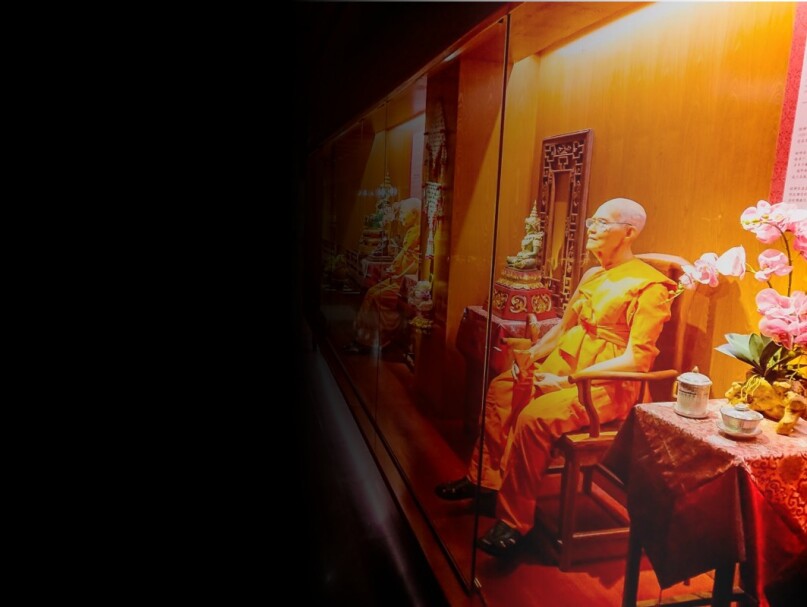
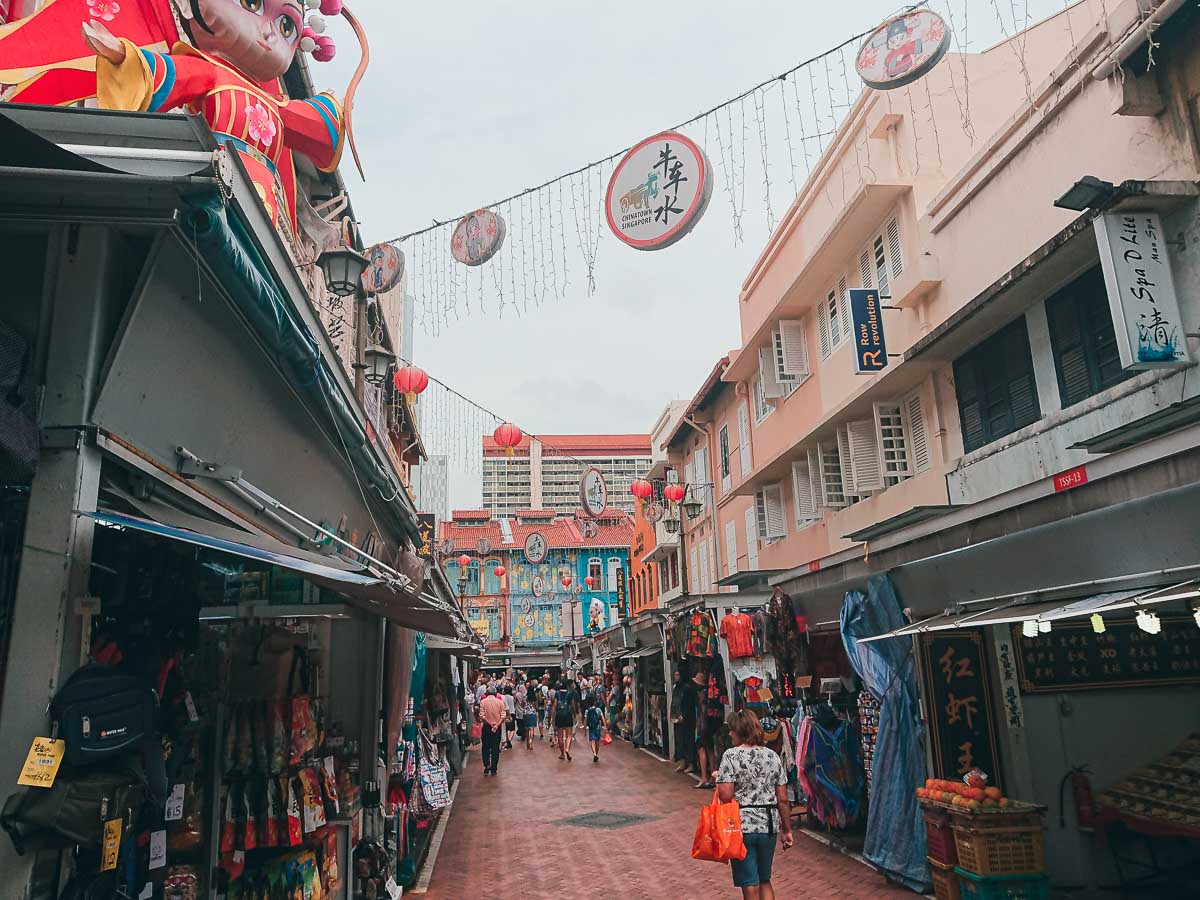
Chinatown
Exploring the Heart of Culture
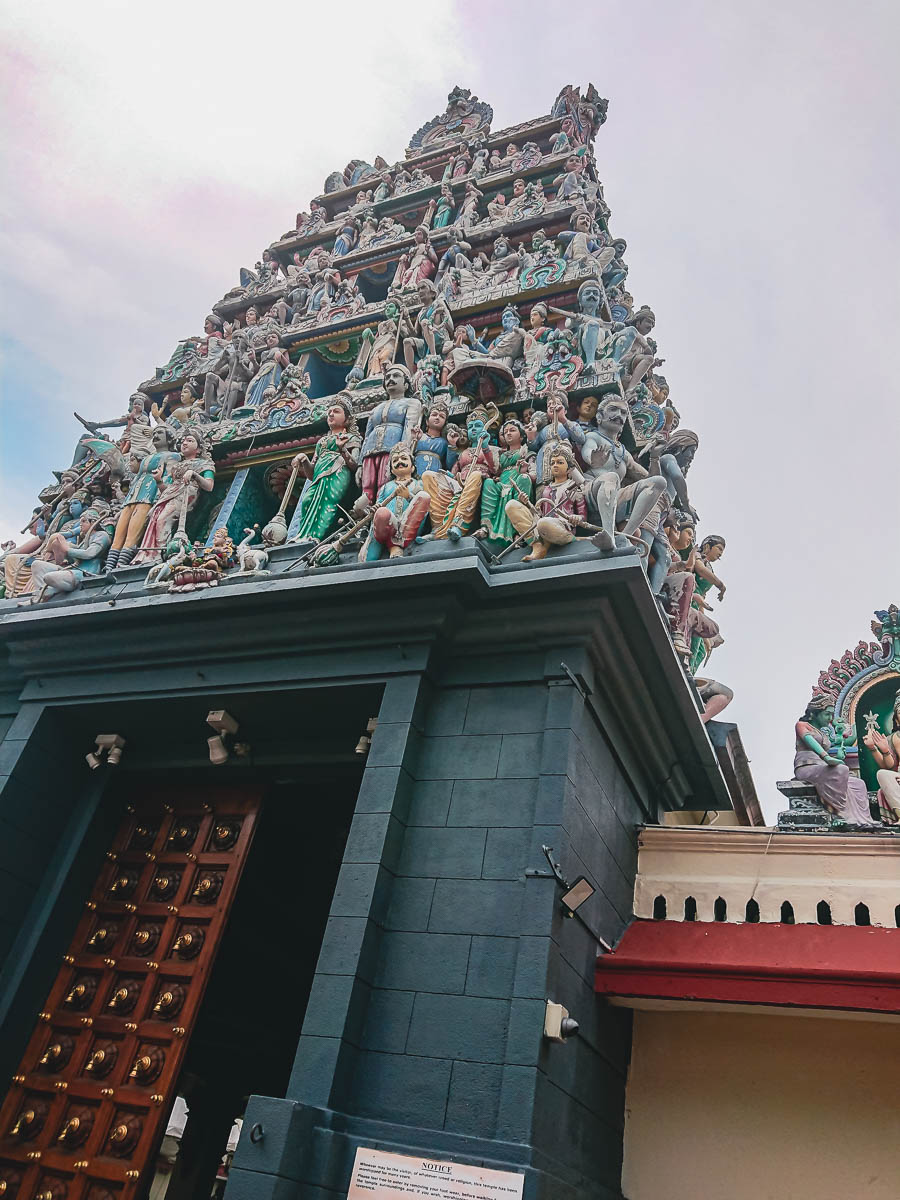
Sri Mariamman Temple
A Glimpse into Spiritual Grandeur
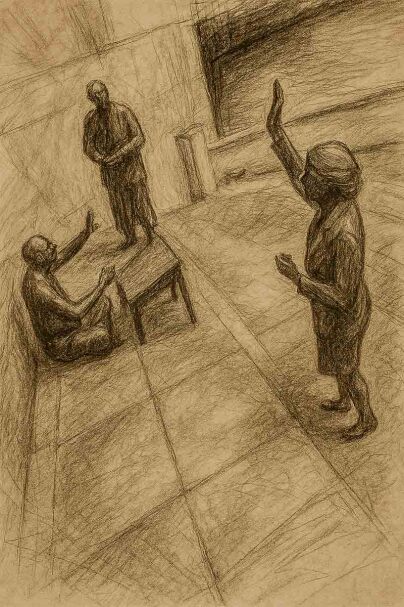
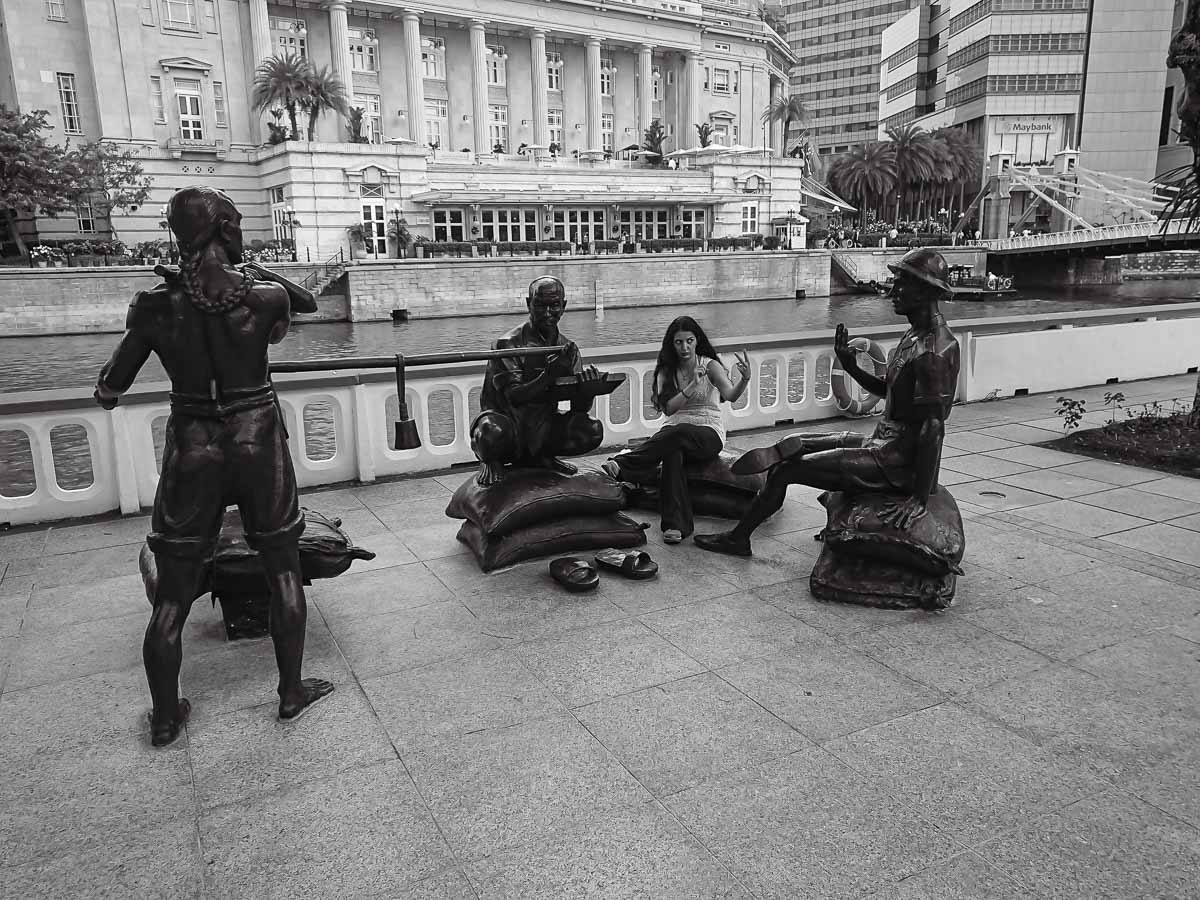
A Great Emporium
Sculpting Singapore’s Trading Past
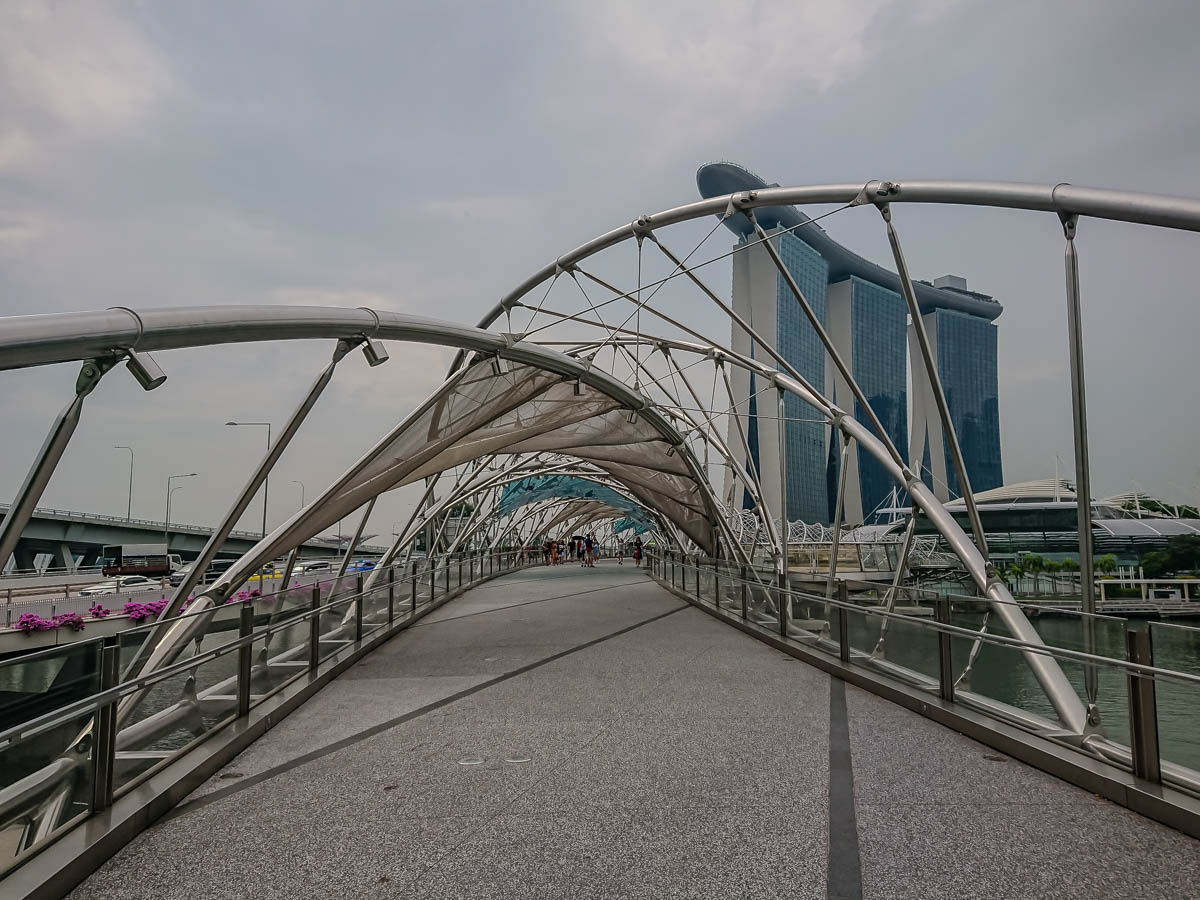
The Helix Bridge
Walking Through DNA
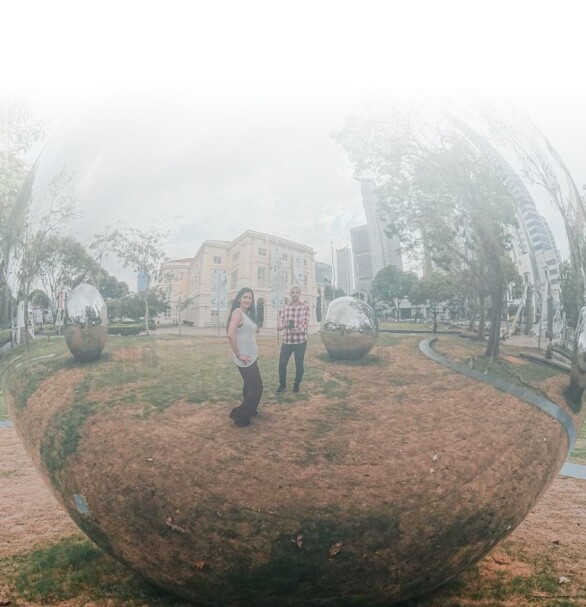
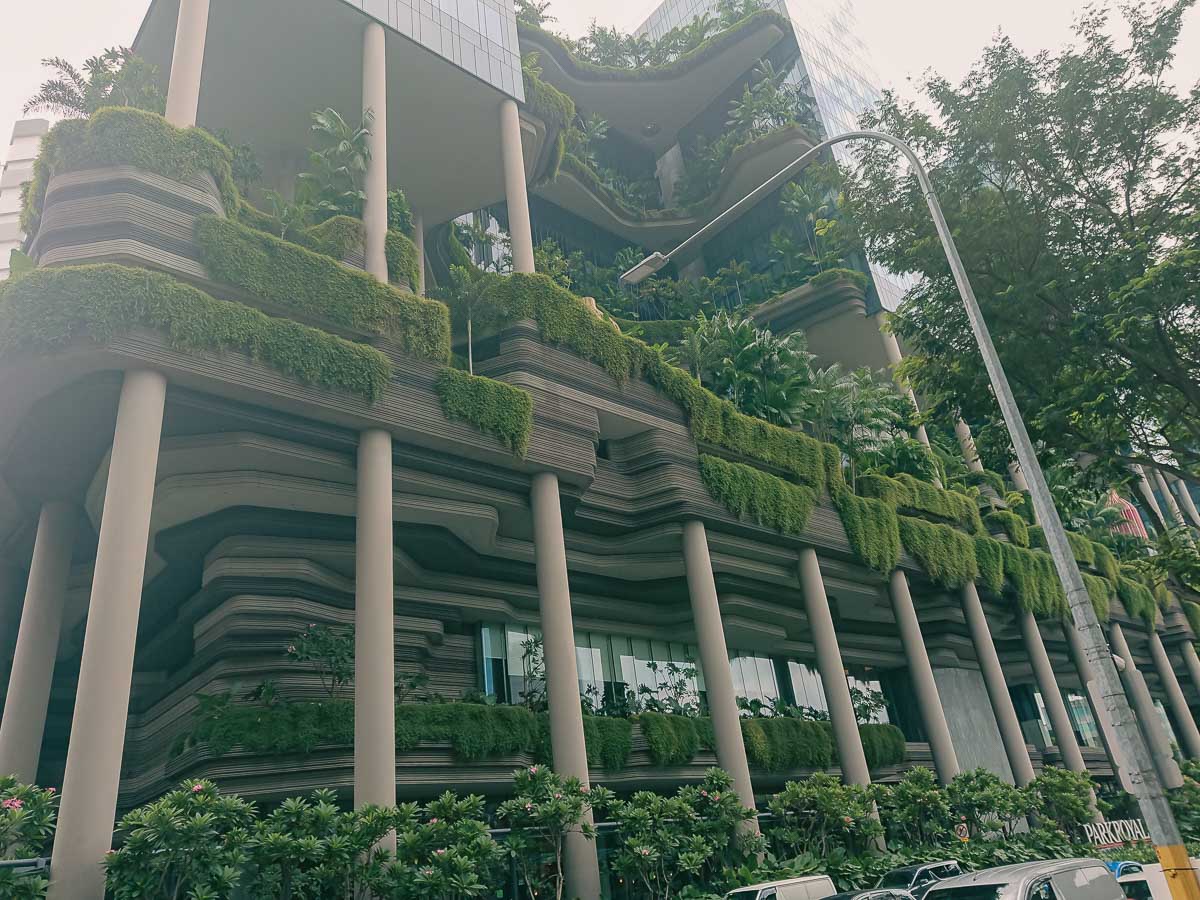
PARKROYAL COLLECTION Pickering
Singapore’s “Hotel-in-a-Garden
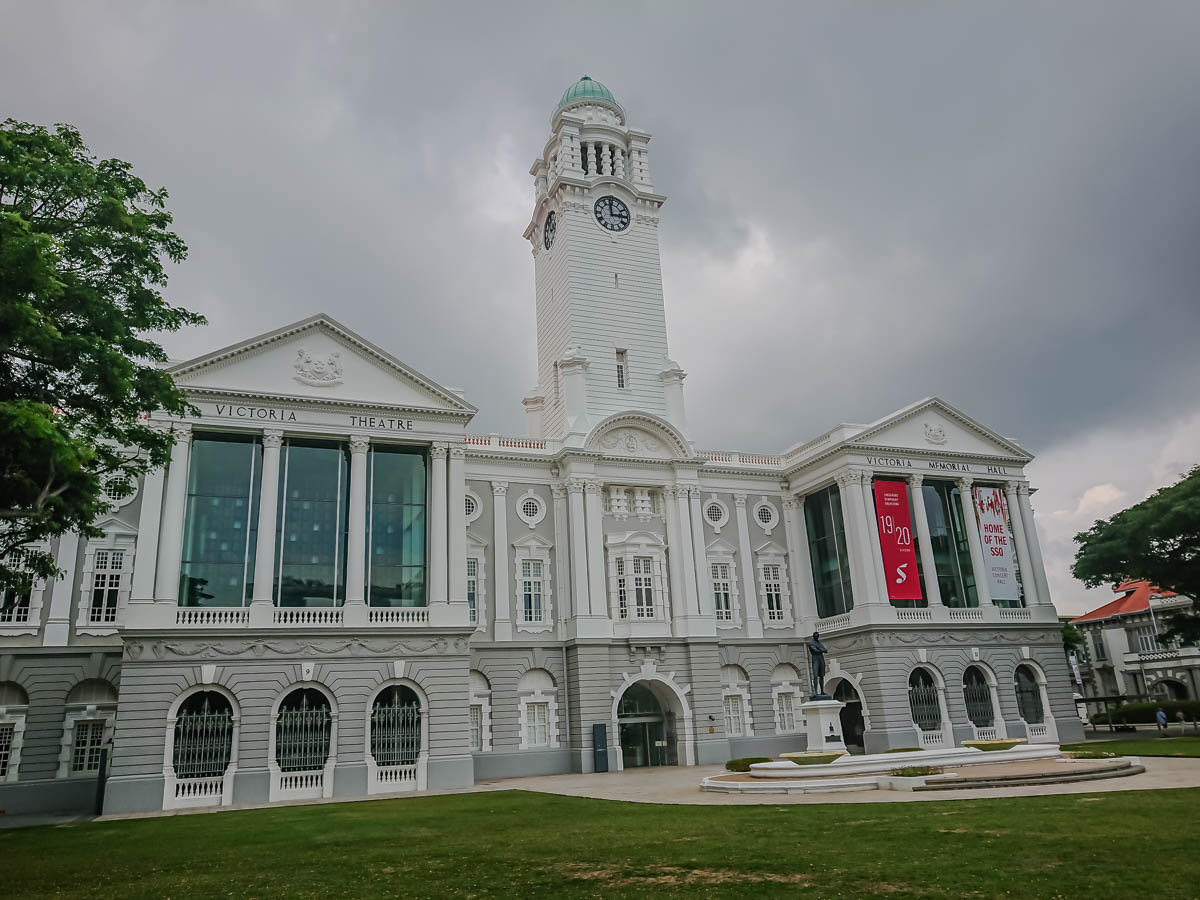
Empress Place
A Historic Jewel by the Singapore River
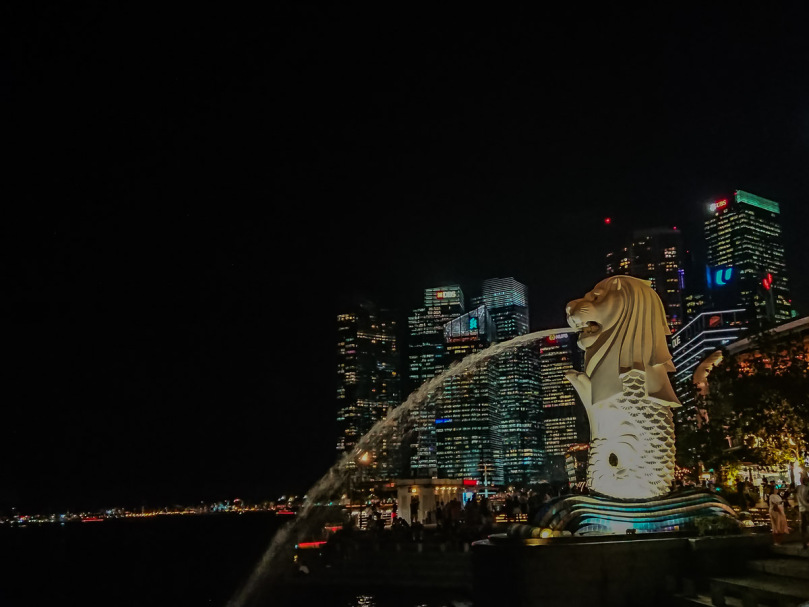
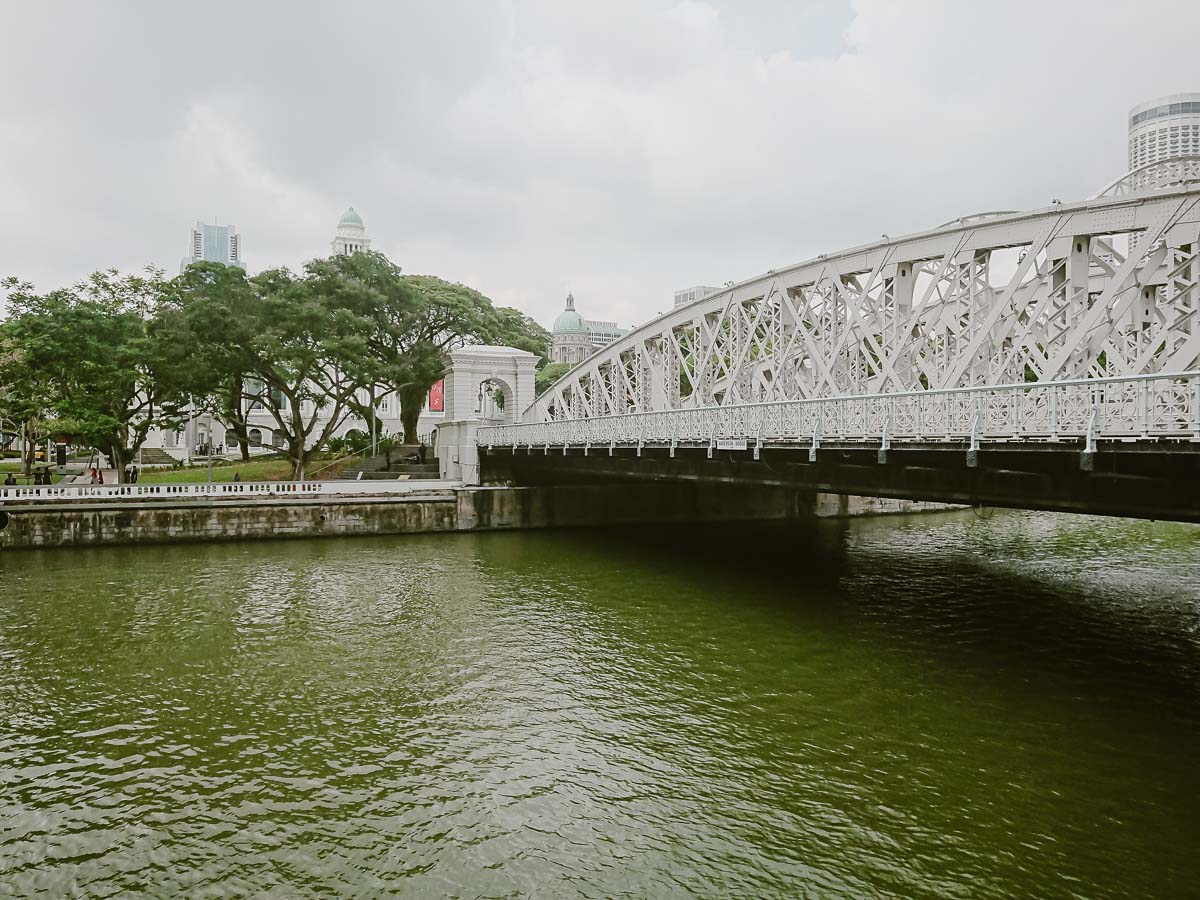
Anderson Bridge
Where Heritage Meets the Flow of Modern Singapore
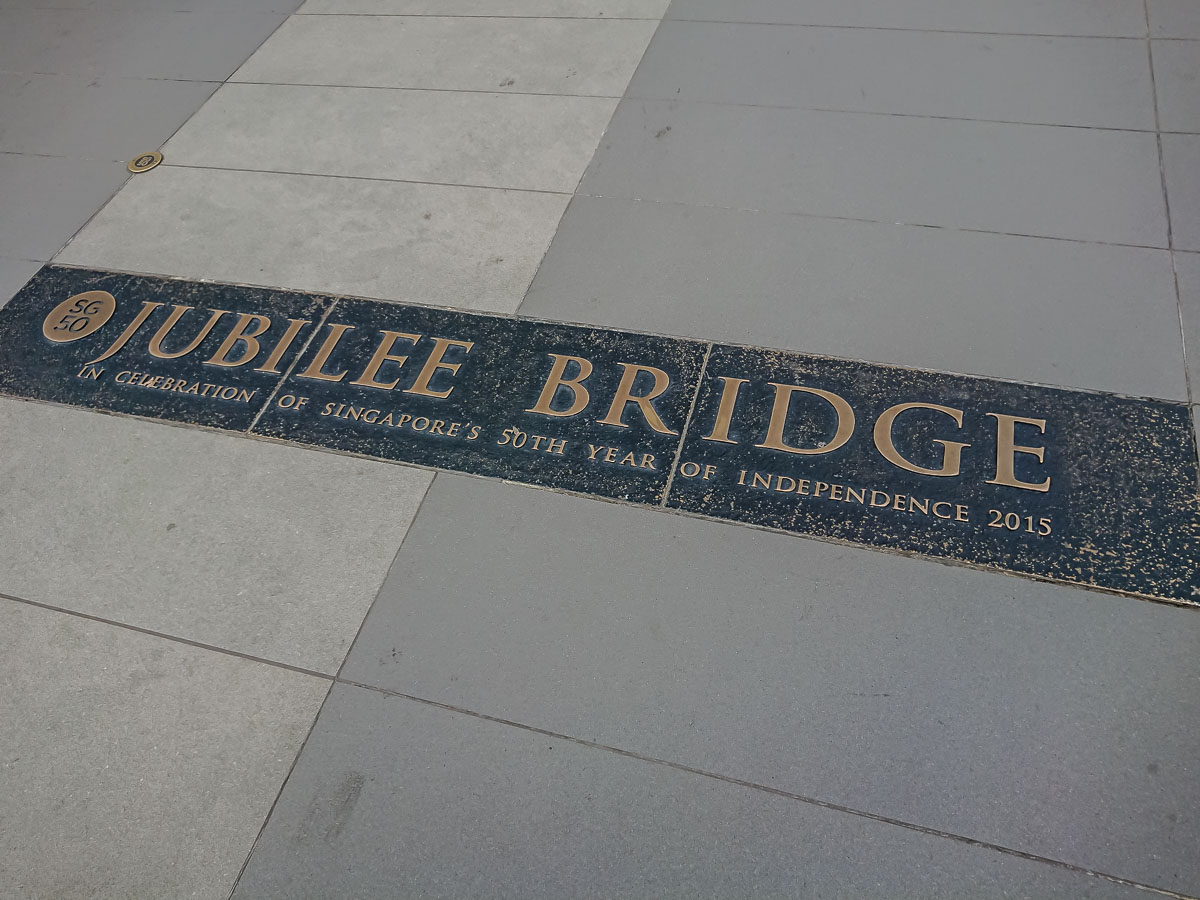
Jubilee Bridge
A Modern Stroll with a Million-Dollar View
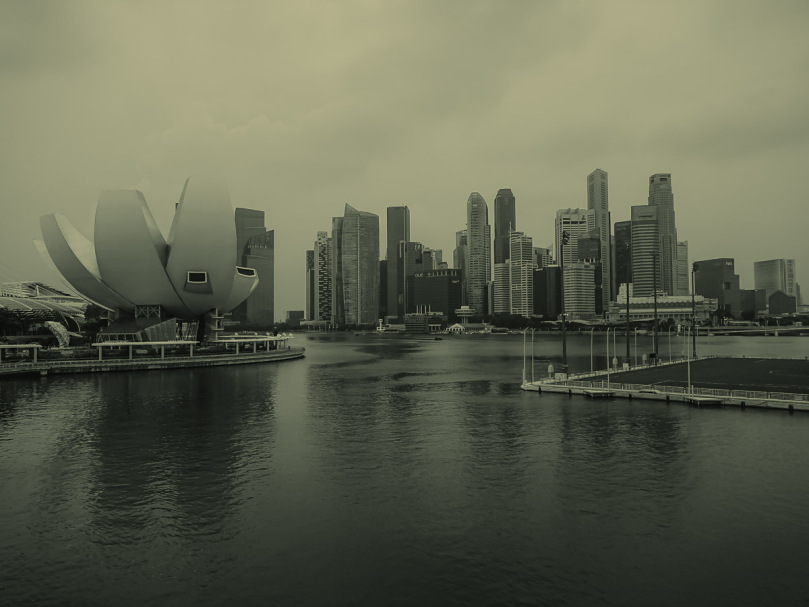
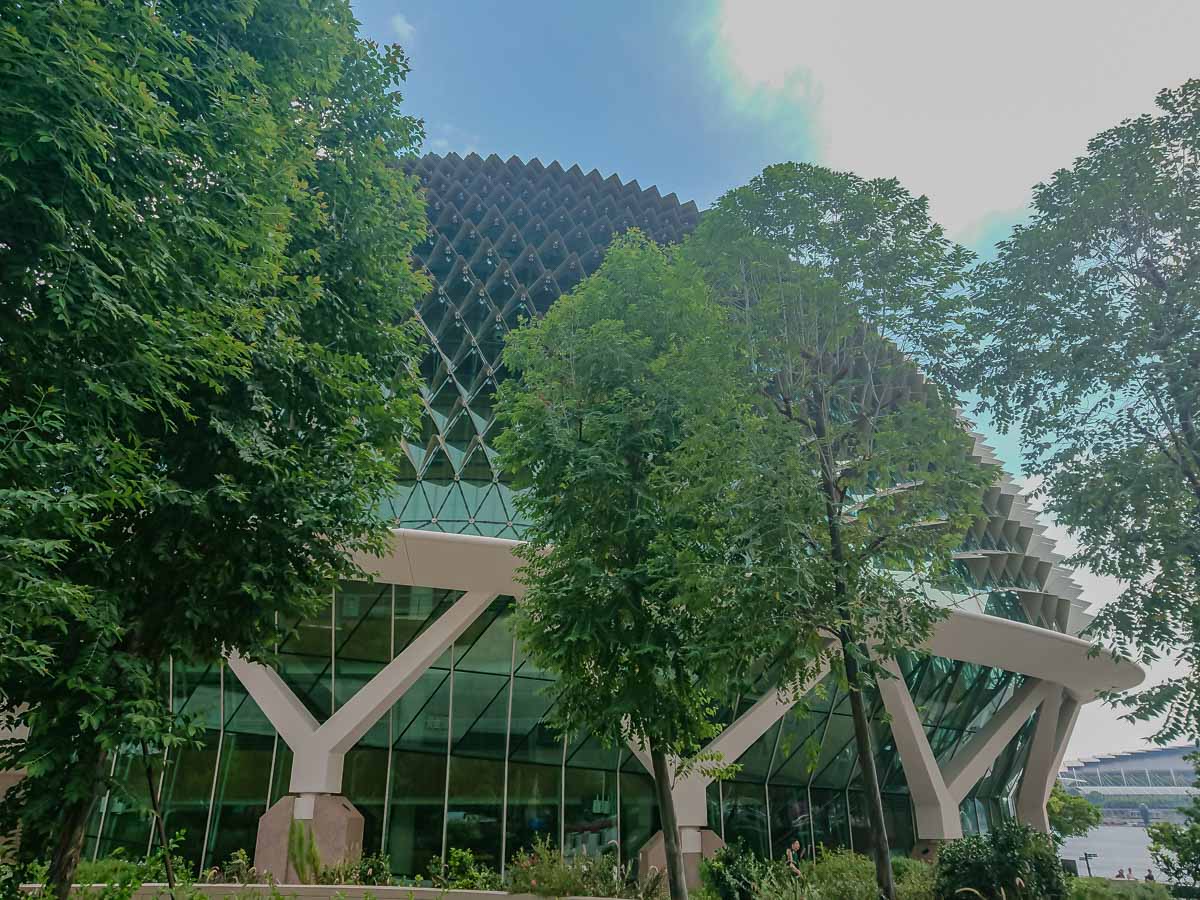
Esplanade – Theatres on the Bay
Where Art Meets Architecture
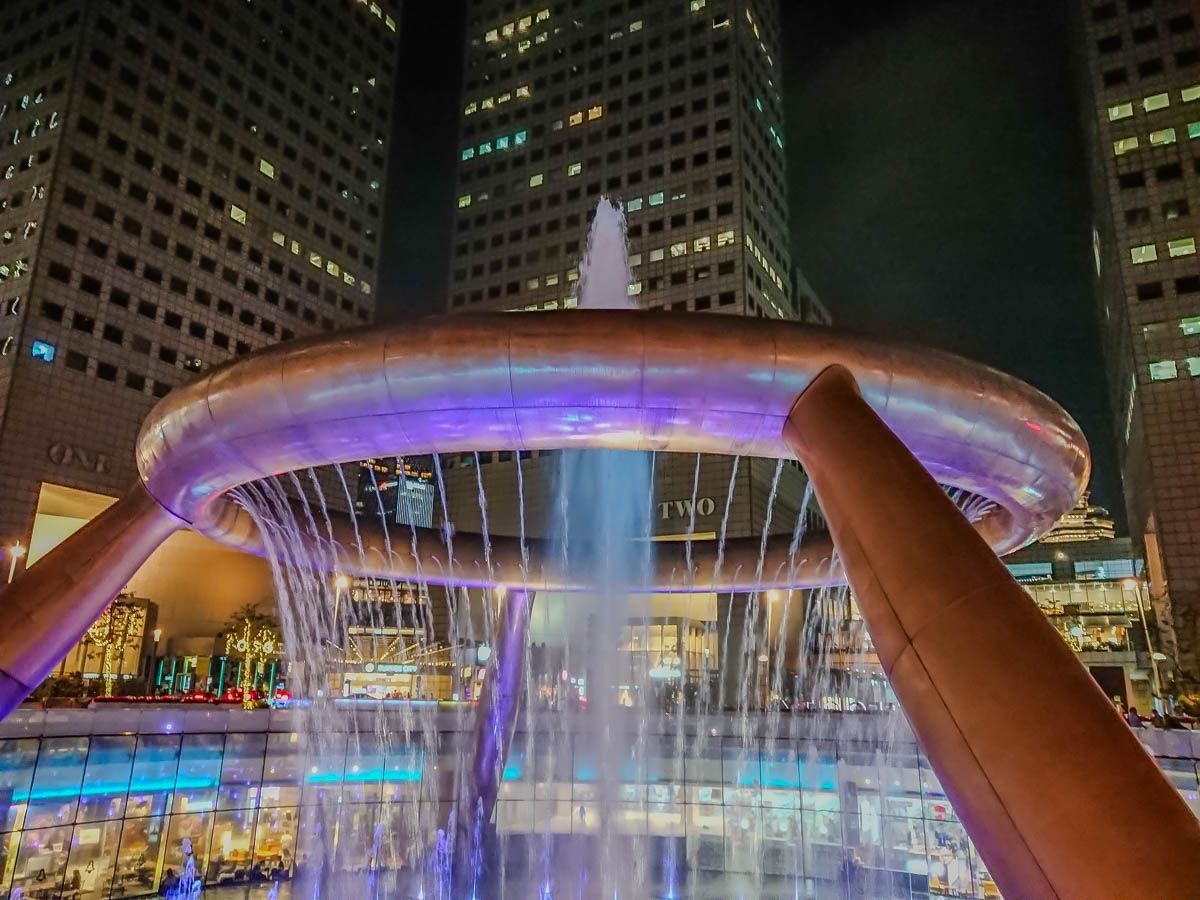
Fountain of Wealth
Let Its Flowing Embrace Turn Your Circles Into Serendipity
The Cenotaph (War Memorial)
White Marble, Black Granite, and the Weight of Memory

Rising 13 meters above Esplanade Park, The Cenotaph is a solemn obelisk of Penang white marble, its black granite base quarried from India—a colonial-era tribute to Singapore’s fallen soldiers. Erected in 1922 to honor WWI victims and later rededicated to WWII casualties, this “empty tomb” (cenotaph) bears the names of 124 individuals etched in English, Tamil, Chinese, and Malay, a testament to the nation’s multicultural identity.
During Japan’s 1942–45 occupation, it was rechristened Syonan Chureito (“Light of the South”), a propaganda symbol later restored to its original purpose. Today, it anchors annual Remembrance Day ceremonies on November 11, when silence falls at 11 AM—a quiet counterpoint to the bustling Singapore River and Asian Civilisations Museum nearby. A monument layered in loss, resilience, and shifting histories.

Standing sentinel on the edge of Padang—a historic cricket field echoing Singapore’s colonial sporting past—this bronze statue of Sir Thomas H. Fabian captures the city’s first elected mayor (1957–1959) in a moment of quiet resolve. Crafted in 1956 by local artist Koh Seow Chuan, the sculpture depicts Fabian holding a scroll, a nod to his blueprint-driven vision for urban reform during a transformative era.
Though a colonial-era figure, his legacy as a knighted public servant endures: he championed infrastructure modernization, shaping the city’s civic identity. Positioned to face the grand Victoria Theatre, the statue subtly bridges governance and culture, while its survival post-independence marks a rare preservation of Singapore’s layered history. A quiet monument to progress, where politics, art, and sport converge.

Visit at dawn or dusk to catch the golden glow of The Cenotaph and Fabian Statue bathed in soft light, avoiding the tropical midday glare. These historic sites sit in a vibrant pocket of the city—a 5-minute stroll to the Merlion’s roar, 10 minutes to Clarke Quay’s riverside buzz, and 15 minutes from Marina Bay Sands’ futuristic skyline.
The park itself offers a rare serene escape , where colonial-era monuments stand in quiet dialogue with Singapore’s glass-and-steel horizon. Reach the area effortlessly via MRT (Raffles Place or Espritu Santo stations) or glide in by river taxi to Boat Quay, where heritage shophouses frame the journey. A seamless blend of accessibility and timeless charm.
JW Marriott Hotel Singapore South Beach
A sleek urban retreat with skyline views and modern comforts

Nestled at 30 Raffles Boulevard in Marina Bay, the JW Marriott Hotel Singapore South Beach merges sleek architecture with modern luxury, offering a sophisticated urban sanctuary. Its striking design features an infinity rooftop pool with panoramic skyline views, contemporary rooms adorned with floor-to-ceiling windows, and tech-forward amenities that blend comfort with innovation.
Positioned steps from Marina Bay MRT and the Esplanade, the hotel provides seamless access to Singapore’s cultural and culinary hotspots, including Gardens by the Bay, Marina Bay Sands, and Clarke Quay. On-site dining options cater to refined tastes, while its vibrant locale ensures travelers remain connected to the city’s pulse—perfect for those seeking both indulgence and immersive exploration in one of Singapore’s most dynamic districts.
Singapore Botanic Gardens
A Green Escape in the Heart of the City
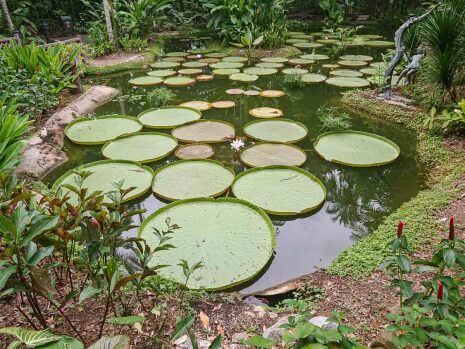
Singapore Botanic Gardens, a UNESCO World Heritage Site since 2015, is the world’s first tropical garden to receive this honor. Spanning 82 hectares just minutes from the city center, this historic oasis—established in 1859—blends lush biodiversity with cultural heritage. Wander through themed gardens showcasing over 10,000 plant species, from the vibrant National Orchid Garden to the tranquil Swan Lake and protected rainforest pockets teeming with wildlife.
Designed for serenity, it offers a green escape amid skyscrapers, perfect for nature lovers, photographers, or anyone seeking peace. With its legacy of conservation and accessibility, the gardens remain a living museum where history, science, and natural beauty converge.
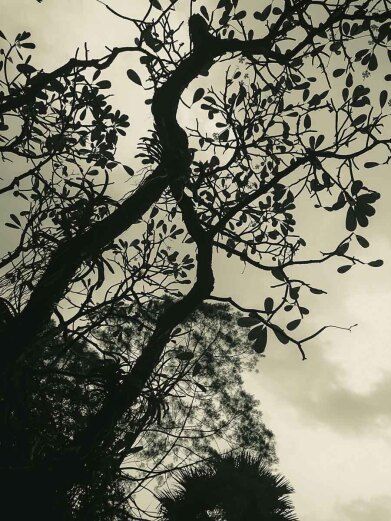
Singapore Botanic Gardens’ must-see highlights include the National Orchid Garden , bursting with 1,000 species and 2,000 hybrids—including Singapore’s national flower, the Vanda Miss Joaquim —alongside rare blooms. Nearby, Swan Lake enchants with water lilies and graceful swans, ideal for photos or quiet reflection. The 6-hectare Rain Forest , one of the oldest sections, teems with native wildlife like frogs, monitor lizards, and rustling palms.
Families will love the Jacobian Children’s Garden , where water play zones and discovery trails make learning about ecosystems fun. At Tanglin Gate , the iconic Sir Stamford Raffles Bust marks the main entrance, leading to the historic Bandstand, which occasionally hosts free weekend concerts. Together, these attractions blend natural wonder, education, and heritage into a vibrant urban escape
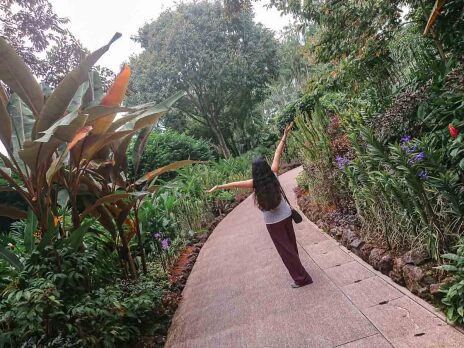
Singapore Botanic Gardens offers diverse ways to explore its lush expanse. Join free guided walks to uncover hidden history and botanical wonders, or unwind with a picnic on the Great Lawn beneath towering trees. Discover plant science and colonial heritage at the Botany Centre , or cycle scenic trails on rented bikes or e-scooters. For photographers, sunrise/sunset bathes the gardens in soft light, while macro lenses reveal rainforest textures and orchid reflections in ponds.
Open daily from 5 AM–midnight , entry is free except the National Orchid Garden (SGD $5 adults, $1 children/seniors). Located at 1 Cluny Road , it’s accessible via Botanic Gardens MRT (Circle/North-South Line), buses, or a 15-minute walk from Marina Bay’s JW Marriott. Whether seeking adventure, education, or tranquility, the gardens blend nature, culture, and accessibility for all.
Buddha Tooth Relic Temple
A Journey into Serenity
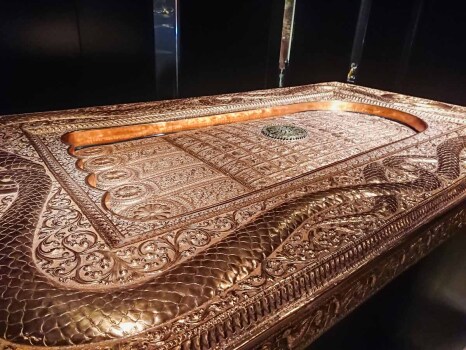
More than simply a house of worship, the Buddha Tooth Relic Temple and Museum is a masterwork of spiritual architecture, cultural diversity, and subdued devotion, all nestled in the center of Singapore's bustling Chinatown. This temple provides a deep experience for anybody, whether they are a devoted Buddhist, an architecture enthusiast, or just an inquisitive tourist.
The temple was finished in 2007 and combines contemporary architecture with the elaborate, symmetrical, and intricate architectural style of the Tang Dynasty. It is solely open to monks, although tourists can see it from a public gallery. It is named for a revered Buddha's tooth relic that is kept in a golden stupa on the fourth floor. With monks chanting gently and worshipers praying, the mood is intensely spiritual.
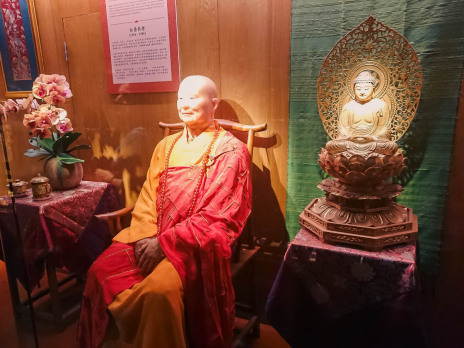
This temple is more than just a beautiful main hall; it also serves as a museum, cultural center, and spiritual retreat. The Hundred Dragons Hall, with golden statues and vibrant décor, the Buddhist Culture Museum, showcasing sacred items, the Sacred Light Hall, housing the Buddha Tooth Relic and a dazzling stupa, and the peaceful Rooftop Garden, with a prayer wheel, greenery, and Singapore's national flower, the orchid, are all must-sees.
This temple strikes a mix between grandeur and intimacy, maintaining a serene atmosphere despite tourists. The air is thick with incense, saffron-robed monks glide through hallways, and gongs or chanting contribute to the peaceful atmosphere. Entry is free, but modest dress is requested; shawls are supplied at the entrance if necessary.
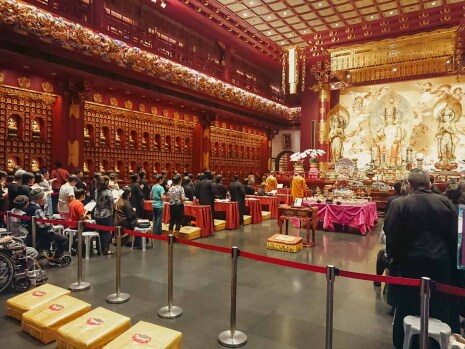
Practical Tips
Open everyday from 7 a.m. to 7 p.m. Early morning is the best time to visit for a more tranquil and cooler atmosphere.
Located at 288 South Bridge Road, Chinatown, Singapore. The nearest MRT station is Chinatown (Exit A).
The Buddha Tooth Relic Temple is a must-see, not only for its spiritual significance, but also for the peace it provides in the midst of Singapore's hectic pace. It exemplifies Buddhist devotion and the city's eclectic culture. Even a quick visit might provide a sense of calm and introspection.
Chinatown
Exploring the Heart of Culture
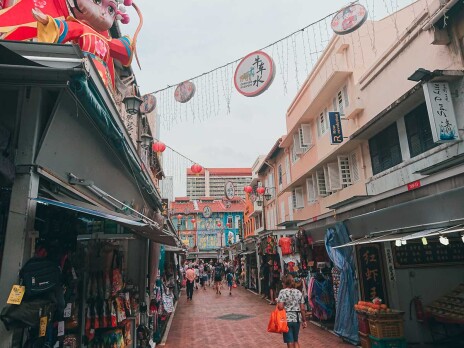
Overview
If there is one district in Singapore that seamlessly blends history, tradition, and current energy, it is Chinatown. This vibrant quarter is more than simply a cultural hub; it's a sensory journey through the past and present, weaving a vivid tapestry of stories, tastes, and architectural marvels.
A Walk Through Time
Chinatown evokes a sense of nostalgia. Its historic shophouses, with their bright façade and tiled roofs, recall Singapore's colonial past. Some 19th-century buildings have been converted into teahouses and galleries. The breathtaking Buddha Tooth Relic Temple, a Tang-style masterpiece, combines spirituality and culture. With its stately interiors, prayer sessions, and calm rooftop garden, it provides a pleasant retreat for all guests.

Street Life and Market Vibes
Stroll down Pagoda and Trengganu Streets, where souvenir sellers, silk stores, and Chinese medicine halls are thriving.
As residents and tourists enjoy the bustling environment, the air is filled with the fragrances of incense, spices, and street cuisine. Intricate murals show daily life in ancient Chinatown, paying homage to the neighborhood's immigrant and working-class roots.
A food lover's paradise
Chinatown is a sensory delight, with Michelin-starred street cuisine and cheap dumpling vendors. For local favorites such as Hainanese chicken rice and chili crab, head to the busy Chinatown Complex Food Centre. A journey down Smith Street ("Food Street") provides a magnificent dining experience, with lantern-lit tables and the smells of sizzling woks creating an amazing ambiance.
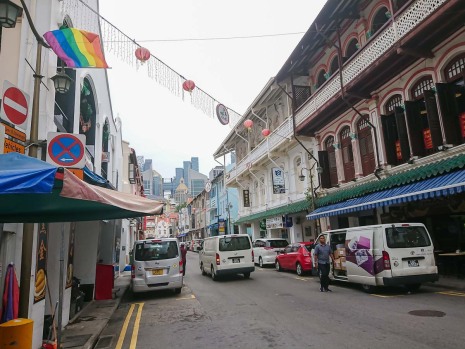
Where Past Meets Present
Singapore's Chinatown brilliantly combines tradition and contemporary. In addition to old temples and shophouses, refurbished historical buildings host stylish cafés, rooftop bars, and co-working spaces. This balance of old and modern reflects Singapore itself—a city that values its history while forging ahead.
Pro Tip:
Visit during Chinese New Year for stunning lanterns, energetic performances, and vibrant night markets. Join a history trip to discover Chinatown's hidden stories. For a peaceful rest, visit Ann Siang Hill Park, a calm green oasis with breathtaking views near Club Street.
Sri Mariamman Temple
A Glimpse into Spiritual Grandeur
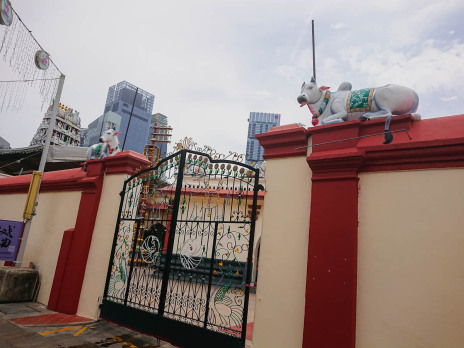
A vivid first impression
The temple's tall gopuram, adorned with bright sculptures of Hindu gods and fantastical creatures, immediately draws visitors in.
Every detailed element conveys a tale, enticing visitors to appreciate the workmanship. Built in 1827 by Indian immigrant Naraina Pillai, this ancient sanctuary began as a Tamil Hindu devotional place and is now open to both believers and travelers.
A tranquil sanctuary
The busy streets melt away as you enter, revealing a tranquil sanctuary filled with incense and jasmine. The temple bells clang as priests perform ceremonies, and devotees pray and light candles for Sri Mariamman, the protecting goddess.
Inside, shrines to Durga, Ganesh, and Shiva contain bright sculptures and painted ceilings that represent Hindu beliefs.
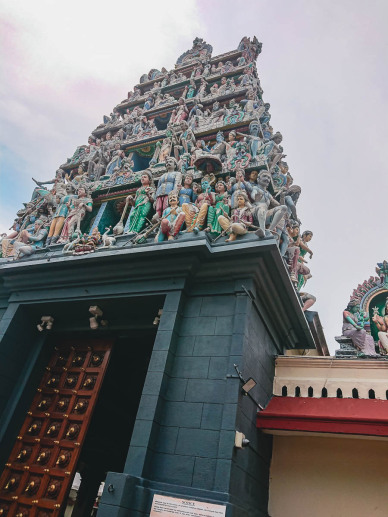
A vibrant cultural hub
Sri Mariamman Temple is more than simply a place of worship; it is the heart of Singapore's Indian community.
It glows brightly at Hindu festivals, particularly Theemithi, when devotees walk across hot coals in an awe-inspiring display of faith.
Visit during a festival to witness the temple illuminated with lighting, garlands, and happy music, brimming with cultural vitality.
Reasons to visit
Even non-religious visitors can admire Sri Mariamman Temple's cultural significance and breathtaking workmanship.
It embodies Singapore's cosmopolitan spirit, in which different faiths cohabit.
Entry is free (donations are accepted).
Dress modestly (cover shoulders/knees) and remove your shoes.
Photography is permitted in specific places; please be attentive during prayers.
From Chettiars to Financiers
Telling Stories Through Bronze
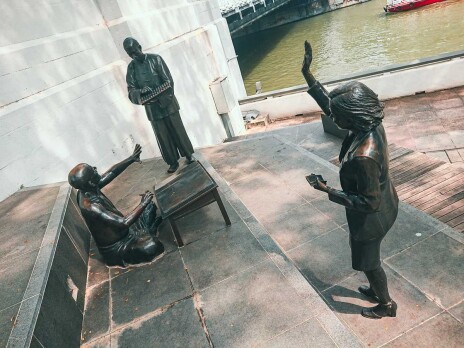
Overview
A quietly striking bronze sculpture named "From Chettiars to Financiers" rests on the outskirts of Raffles Place, Singapore's thriving financial hub.
While surrounded by contemporary skyscrapers and slick office complexes, this sculpture transports you back in time, to a time when Singapore's economic heartbeat had a totally different rhythm.
A Bronze Homage
Crafted by Singaporean sculptor C.H. Tong, this striking artwork honors a distinctive era in the nation’s financial past—the contributions of the Chettiars. Originating from South India, these traditional moneylenders were vital to Singapore’s economic growth during the 19th and early 20th centuries. The sculpture serves as a lasting tribute to their significant role in shaping the country’s prosperity.
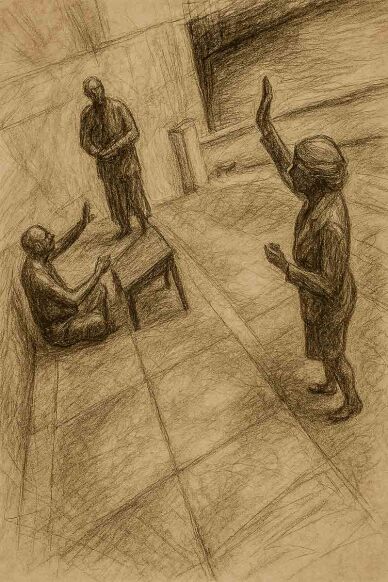
Past & Present Finance
Though modest in scale, this sculpture is deeply symbolic. It depicts a cross-legged Chettiar seated among scrolls, ledgers, and coins—symbols of his trade. Beside him stands a contemporary banker in a suit, holding a briefcase and smartphone. This contrast highlights Singapore’s financial journey—from traditional, trust-based lending to today’s tech-driven, global banking hub.
History Carved in Metal
This sculpture honors the Chettiars—moneylenders from Tamil Nadu who shaped Singapore’s early economy.
Before modern banks existed, they provided vital loans to traders, businesses, and colonial officials from their humble kittangis (office-homes) in areas like Market Street.
Their trusted lending practices helped fuel the city’s growth, laying the foundation for today’s thriving financial sector.

Time Stands Still
Tucked in Singapore's bustling heart, this sculpture offers a quiet moment. More than art, it's a story in bronze—reminding us that beneath the modern skyline lie tales of immigrants, risk-takers, and community builders. The Chettiar and modern banker stand side by side, showing how progress honors heritage. Perfect for thoughtful travelers seeking meaningful snapshots and insights into Singapore's evolution.
Travel Tip:
Spot this sculpture near Raffles Place, between UOB Plaza and the Singapore River. Pair your visit with a stroll through the Civic District—an open-air gallery of public art narrating Singapore’s past. For the best experience, come at sunset: golden light illuminates the bronze, and the fading business buzz lets you appreciate it in quiet serenity.
A Great Emporium
Sculpting Singapore’s Trading Past
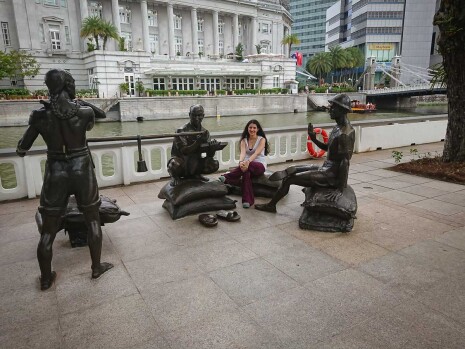
Riverside Chronicles
Strolling along the Singapore River near Boat Quay, you'll discover "A Great Emporium" - not just a sculpture but a storyteller in bronze. Part of the Open Air Interpretive Centre, this dynamic piece forms a visual timeline of Singapore's remarkable transformation from sleepy fishing village to thriving global port. Perfect for history-loving travelers seeking meaningful moments along their waterfront walk.
Portrait of Trade
This captivating bronze sculpture freezes a vibrant moment from 19th-century Singapore - merchants haggling, laborers unloading goods, bullock carts piled with produce. Life-sized figures pull you into their world, their dynamic textures suggesting paused motion. While kids play on it and tourists snap photos, "A Great Emporium" quietly reveals Singapore's origins as a thriving multicultural port.
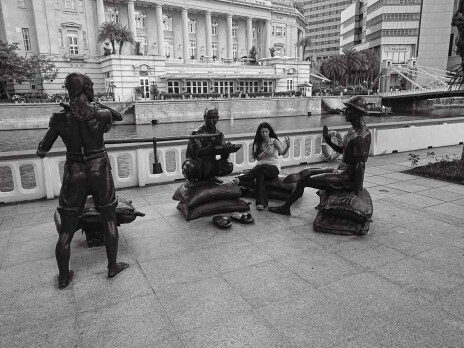
What sets A Great Emporium apart?
This isn't a museum; it exists where history transpired, mixing past and present along the Singapore River. More than just sculpture, it's a 3D tale in which traders' lifelike motions and filled carts faithfully recreate the 1800s trading frenzy. There is no need for a guide; simply linger and let the bronze sculptures take you through time.
A Living History Lesson
Malcolm Koh's masterwork honors Singapore's 19th-century status as a thriving entrepôt, the major commercial hub Raffles envisioned. Lifelike Chinese, Indian, and Malay merchant figures stand side by side, frozen in mid-barter over spices and silks. While towering buildings now line the riverbanks, this artwork brings you back to the days when bumboats and warehouses thrived here - Singapore's original commercial hub.
The Helix Bridge
Walking Through DNA
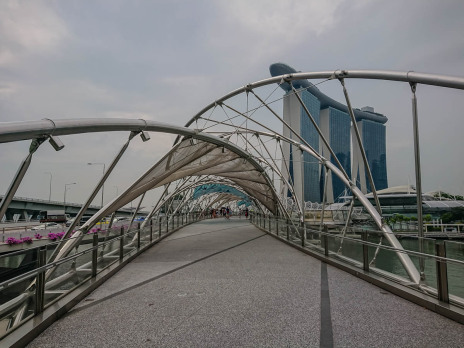
A Structure Inspired by Science
Singapore's Helix Bridge, inspired by the graceful double helix of DNA, is a captivating combination of science and art. Its twisting stainless steel structure wraps over the walkway, forming a sleek, futuristic canopy that appears to float over Marina Bay. By day, its perforated panels provide shade, while at night, LED lights convert it into a dazzling, color-shifting spectacle—both beautiful and well-designed.
A Journey With a View
Beyond its contemporary form, the Helix Bridge boasts spectacular vistas that steal the show. Stroll along its bends and take in the breathtaking views of Marina water Sands, the shimmering water, the lotus-inspired ArtScience Museum, and Singapore's spectacular cityscape. It's the ideal place to snap golden sunsets or the city's electrifying nightscape, thanks to photo-friendly observation pods jutting out over the lake.
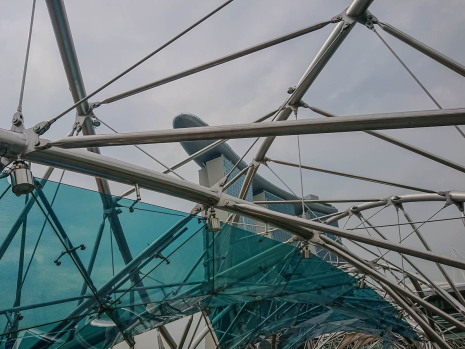
Symbolism in the Spiral
The Helix Bridge is more than just eye-catching design; it tells a deeper tale. Its winding double helix represents life and growth, reflecting Singapore's culture of innovation. Look closely and you'll notice luminous letters (C, G, A, and T) weaved into the artwork, signifying DNA's building components. This brilliant element honors both science and the city's progressive DNA—literally and symbolically!
A Link Between Landmarks
This architectural masterpiece unites Singapore's most stunning districts: Marina Centre's luxury stores and restaurants on one end, Marina Bay Sands' futuristic skyline and Gardens by the Bay on the other. Whether you're on your way to the Spectra Light Show, a Esplanade concert, or simply going for a walk in the evening, crossing the Helix Bridge is a memorable experience.
Mirror Balls sculpture “24 Hours in Singapore”
A Sculptural Reflection of the City
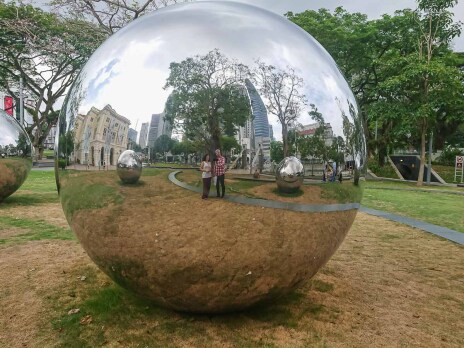
Overview
Five polished steel mirror balls make up the artwork "24 Hours in Singapore" by local artist Baet Yeok Kuan (not Baudoin Mouanda), which is tucked away in Singapore's Esplanade Park.
This subtly lovely artwork pauses onlookers, encouraging both residents and visitors to take a moment to look about and think about themselves.
A Dialogue Between Art & Environment
The mirror balls appear simple at first, but up close, they reveal engraved soundwaves—snippets of Singapore’s daily life: chatter, traffic, rustling leaves. More than decoration, they’re a sensory time capsule.
Reflecting the sky, skyline, and passersby, they mirror both the city’s physical energy and its rhythm, embodying the essence of *"24 Hours in Singapore."*
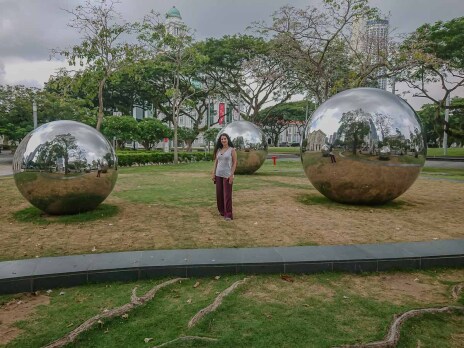
A Place for Stillness Amid Motion
The installation's position in Esplanade Park, between colonial monuments and skyscrapers, provides depth. In the midst of the city's chaos, the mirror balls offer both real and symbolic reflection. At golden hour, sunlight shines on the orbs, and people take pictures or lounge alongside. Your warped reflection among trees and towers feels meditative, quietly affirming your place in Singapore’s ever-unfolding story.
A Favorite Spot for Photographers and Dreamers
"24 Hours in Singapore" is a photographer's fantasy, including surreal reflections and ever-changing setups.
Beyond its visual appeal, the artwork prompts deeper reflection—on urban living, our sense of time, and the noises that shape our days.
It's more than just a photo opportunity; it's a peaceful reflection on life in a hectic metropolis.
PARKROYAL COLLECTION Pickering
Singapore’s “Hotel-in-a-Garden”
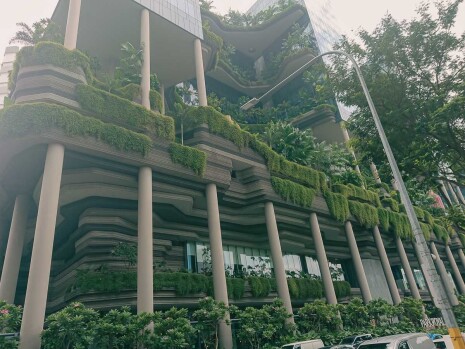
Nature Meets Architecture
The hotel's most notable feature is its beautiful vertical gardens—tropical plants pouring down tiered balconies like a living cascade. Designed by WOHA, its curving exterior resembles rice terraces and cliff formations, resulting in a "hotel-in-a-garden" idea that combines sustainability and elegance. Over 15,000 square meters of sky gardens and waterfalls combine nature and design, creating a contemporary but calm urban retreat.
Calm Above the City
The interiors combine modern elegance with zen tranquility—airy rooms have earthy tones, wood accents, and floor-to-ceiling windows that frame lush flora against the city skyline. Waking up here feels like you're in a luxury urban treehouse. Upgrade to a Collection Club Room for access to the rooftop lounge, where breakfast and sunset drinks are served in private style with panoramic views of Marina Bay.
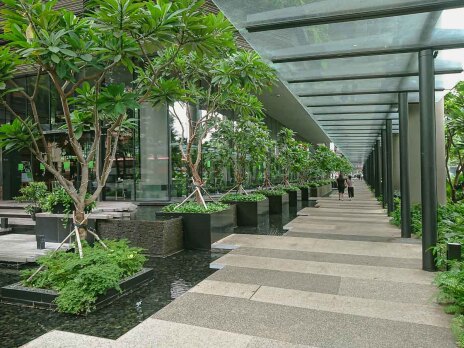
The Infinity Pool
The hotel's crown treasure is its 5th-floor infinity pool, one of Singapore's most picturesque sites. The pool is surrounded by magnificent vertical gardens and offers views of the skyline. It also has unusual birdcage-shaped cabanas. Suspended above the city, it offers a peaceful sanctuary where you may relax while feeling weightless, as if you're floating on a tropical cloud above the metropolitan energy below.
A Leader in Sustainable Luxury
Parkroyal Collection Pickering combines sustainability and luxury through rainwater collecting, solar electricity, and sophisticated sensors. Its characteristic green façade naturally cools the building, and the on-site urban farm provides fresh food for Lime, a must-see restaurant known for its creative à la carte meals and opulent foreign buffets. Proof that eco-friendly design can be both responsible and luxurious.
Empress Place
A Historic Jewel by the Singapore River
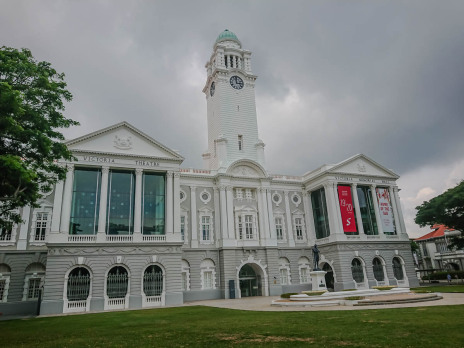
A Colonial Landmark with a Regal Name
Empress Place, named after Queen Victoria, is home to the landmark 1860s neo-Palladian structure, a marvel of British colonial architecture with Doric columns, arched verandahs, and French windows.
The painstakingly rebuilt edifice, which was once government offices, is now part of the Asian Civilisations Museum (ACM), Singapore's main cultural attraction as well as a historical monument.
Culture by the River
Empress Place is located in the heart of Singapore's cultural corridor, only steps from Victoria Theatre and the National Gallery.
Its crown gem is the Asian Civilizations Museum, which is situated in the ancient Empress Place Building. The museum's spectacular displays highlight Asia's rich past, while its elegant interiors—with soaring atriums and river views—fuse modernism and imperial grandeur.
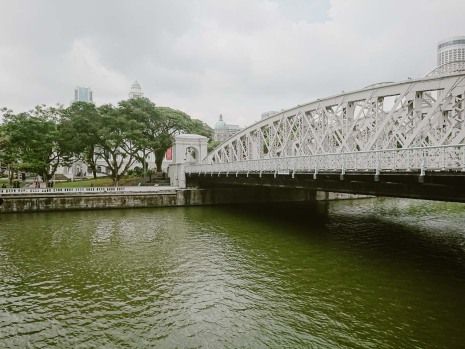
A Riverside Retreat
The Empress Place riverside glows at twilight, with palm-framed colonial buildings and ethnic sculptures making for a lovely promenade.
Wedding photographers and artists frequently capture its allure.
Nearby, heritage marvels await: the majestic Fullerton Hotel (a converted post office) and Cavenagh Bridge, Singapore's 19th-century iron suspension bridge with decorative embellishments.
Dining with a View
Empress, located adjacent to the museum, serves contemporary Cantonese cuisine. Dine riverside on chili crab, dim food, and roasted duck while Clarke Quay's lights dance over the water.
The atmosphere is refined yet informal, making it ideal for lingering over dinner while overlooking Singapore's ancient waterfront.
Anderson Bridge
Where Heritage Meets the Flow of Modern Singapore
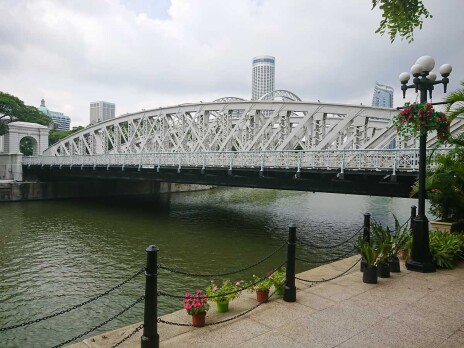
Where Commerce Met Steel
Anderson Bridge, named after Straits Settlements Governor Sir John Anderson, was built in 1910 to ease traffic congestion on Cavenagh Bridge. It boasts unusual steel truss arches. It was formerly crucial to Singapore's trade-heavy river economy, with goods-laden boats crowding the quays, but it now stands as an elegant relic amid contemporary buildings, silently documenting the city's change from colonial port to global metropolis.
Architectural Elegance
Anderson Bridge is charming with its creative steel latticework, decorative lighting, and airy white frame. At dawn or dark, sunlight reflects on its metal ribs, and the river shimmers underneath.
By night, mellow lighting offers a lovely contrast against modern buildings, attracting photographers, lovers, and anybody looking to relish this lyrical blend of antiquity and metropolis.
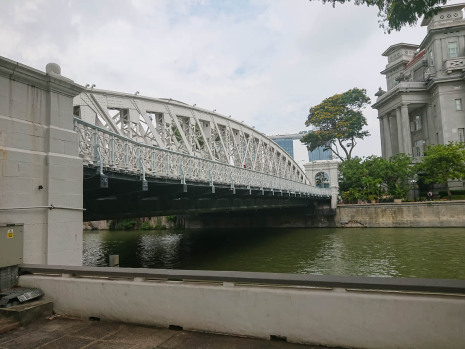
A Symbol of Continuity
Anderson Bridge, which is still operational after more than 110 years, silently handles everyday traffic while standing witness to history. It has held national day festivities and Formula One races, serving as a showcase for modern Singapore.
This living relic, designated as a National Monument in 2019, now has protected status while continuing its unassuming function as a transportation corridor and historical landmark.
What to Do Nearby
Flanked by heritage landmarks, Anderson Bridge anchors a scenic riverside stroll. One side leads to the Fullerton Hotel and bustling Boat Quay, while the other connects to Empress Place and the Asian Civilisations Museum.
Nearby, Cavenagh and Elgin Bridges complete a charming heritage circuit of Singapore's historic river crossings - perfect for exploring the city's past and present in one walk.
Jubilee Bridge
A Modern Stroll with a Million-Dollar View
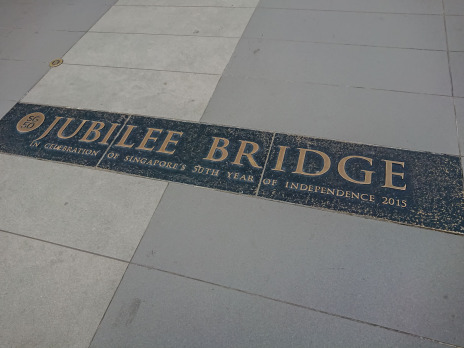
Overview
Exploring a city on foot is frequently the best option, and Singapore's Jubilee Bridge provides a magnificent, photogenic promenade.
This pedestrian bridge, which connects Esplanade Drive and Merlion Park, is more than simply a crossing; it's also a place to pause, admire the skyline, and get a new, higher view of Singapore.
A Bridge Built for the People
Jubilee Bridge, built in 2015 to commemorate Singapore's 50th anniversary (SG50), was inspired by the late Prime Minister Lee Kuan Yew's idea for a safer riverbank stroll.
It is wider and more welcoming than the bustling Esplanade Bridge, and its sleek, curving shape merges with the skyline, providing breathtaking vistas of the city's monuments.
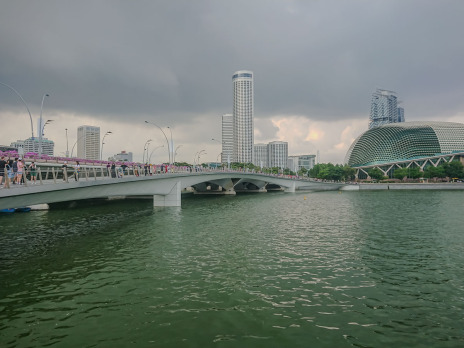
The Best Views in the City
🎭The Merlion in full profile, spewing water into the bay.
🏨The stunning Marina Bay Sands hotel rises in the distance.
🌸The futuristic ArtScience Museum, styled like the lotus
🎭The majestic spires of Esplanade,
Theatres on the Bay
🏛️Turn around to see the magnificent Fullerton Hotel and the bustling Boat Quay neighborhood.
A Symbol of Modern Singapore
This bridge is more than just steel and lights; it expresses Singapore's essence, with clever architecture that appreciates tradition.
Lee Kuan Yew's goal of pedestrian-friendly areas is alive and well, as shown by the hushed footfall of mourners during his goodbye.
The Merlion
Singapore’s Icon with a Splash of Magic
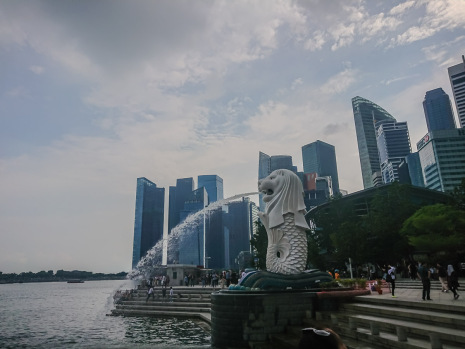
Overview
The Merlion, Singapore's mythological protector who is half lion and half fish, is a well-known emblem.
One of the city's most iconic icons is located at Merlion Park.
It looks great on postcards and souvenirs, but it's much more amazing in real, shooting water into Marina Bay.
A Tale of Two Creatures
The lion head represents "Singapura" (Lion City), while the fish tail represents its past as "Temasek," a fishing community.
Together, they symbolize Singapore's transformation from a seaside hamlet to a worldwide city.
The monument, which stands 8.6 meters tall, overlooks the harbor and is accompanied by a smaller "cub" for humorous pictures.
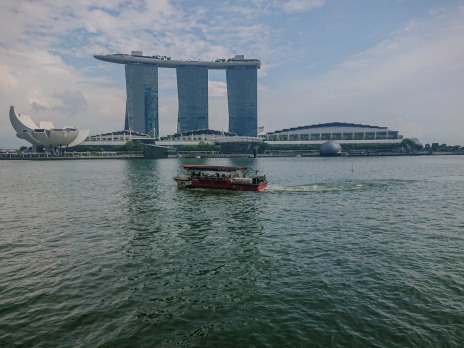
The Best Views in the Bay
Merlion Park has breathtaking vistas beyond its famed monument.
From here, you can see Marina Bay Sands, the ArtScience Museum's lotus form, the Esplanade's glass dome, and Marina Bay's sparkling seas.
Whether at sunrise, noon, or night, the Merlion offers an excellent photo backdrop.
More Than a Photo Stop
Don't just take the typical "drinking" shot; stop and enjoy the occasion. Feel the bay wind, hear the fountain splash, and experience the vibrant energy of people from all over the world.
The Merlion is more than just a monument; it represents Singapore's spirit:
inventive, proud, and forward-thinking while honoring its heritage.
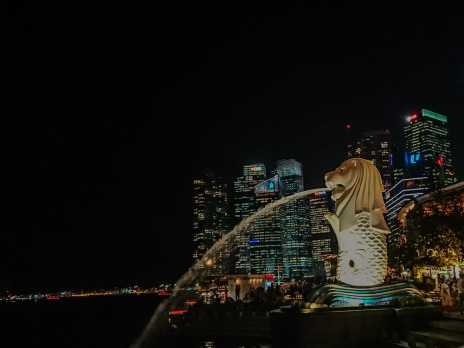
Quick Info
📍 Location:
Near Fullerton Hotel & Esplanade Bridge
🚇 Nearest MRT:
Raffles Place (5-minute walk)
📷 Best Time to Visit:
Early morning or evening for softer light and fewer crowds
🌊 Fun Fact:
Did you know? The 70-ton Merlion was moved here in 2002 from the Singapore River!
Famous Merlion Appearances
The Merlion shines in popular culture!
It has starred in Crazy Rich Asians (2018), travel documentaries, and even cartoon series like as The Amazing Race.
Its distinctive lion-fish design shouts "Singapore," making it both a national symbol and a worldwide celebrity.
Marina Bay
Singapore’s Shimmering Jewel
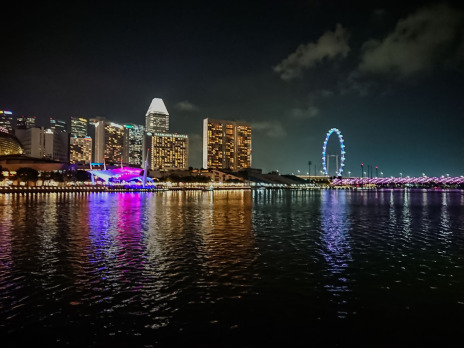
The Skyline
Anchored by the futuristic Marina Bay Sands with its ship-like sky park, Marina Bay's skyline shines like no other.
At night, vibrant lights dance across the bay's waters, and during the day, it has a cinematic effect.
You can take pictures from any angle, so remember to bring your camera!
Water Meets Wonder
Wander around the calm coastline of Marina Bay, where people exercise, perform on the street, and watch the sunset.
Don't miss the famous Merlion, which is a hybrid of a lion and a fish, as it shoots water into the harbor, making for the ideal backdrop for photographs.
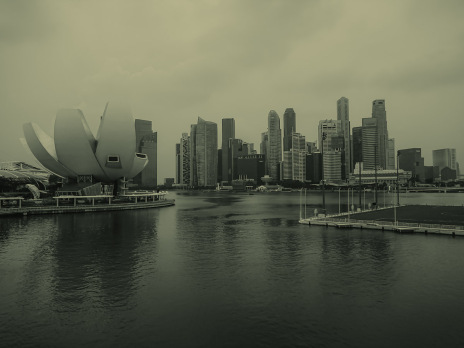
Gardens by the Bay
The bizarre Gardens by the Bay, with its tall supertrees and futuristic greenhouses, is located right next to Marina Bay Sands.
Every evening, the Supertree Grove comes alive with a spectacular display that combines light, music, and creativity.
When you enter the Cloud Forest, you'll be surrounded by tropical vegetation and mist beneath a glass dome. It's nature in a new way.
Food & Flavors with a View
The cuisine in the Marina Bay area is excellent, whether you're enjoying a martini at Ce La Vi atop Marina Bay Sands or some chili crab at the Satay by the Bay hawker center.
Imagine robust spices, global cuisines, and unrivaled vistas.
Try the local, flavorful, and distinctive laksa and Hainanese chicken rice from the food booths in the area.
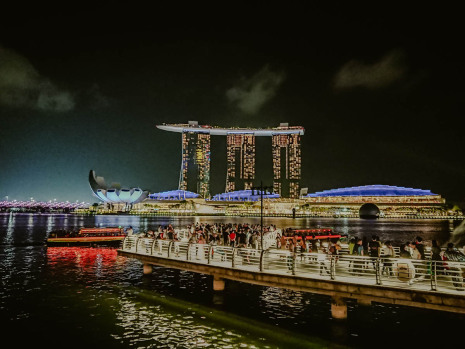
Light Shows & Night Vibes
Marina Bay becomes a stage each night.
The bay is brought to life by the free Spectra Light and Water Show, which takes place at the Event Plaza and features lasers, fountains, and music.
After then, the atmosphere is lively as people relax, walk, talk, and snap selfies. The atmosphere is serene and joyous. It's the ideal spot to wind down after a day in Singapore.
Tips for Visiting Marina Bay
🌊 Late afternoon to nighttime is the ideal time to go. Enjoy the lights after you've seen the sunset.
🌊 The best way to get about is to walk. The entire region is suitable for pedestrians.
🌊 Bring a camera, comfortable shoes, and an open mind.
Esplanade – Theatres on the Bay
Where Art Meets Architecture
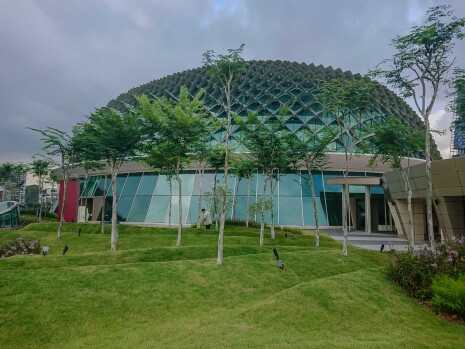
Overview
One of Singapore's most recognizable sights, Esplanade - Theatres on the Bay, is located just along Marina Bay's glittering waterfront.
This cultural center, which is lovingly referred to as "The Durian" because to its spiky appearance, is where passion, design, and performance all coexist together.
Iconic Architecture with a Local Twist
The Esplanade is Singapore's thriving center of the arts in addition to being a famous monument.
It features a theater, gallery, and a music hall that presents anything from contemporary plays to symphonies.
You may observe rehearsals, take in free exhibitions, or just take in the creative spirit of this vibrant venue without a ticket.
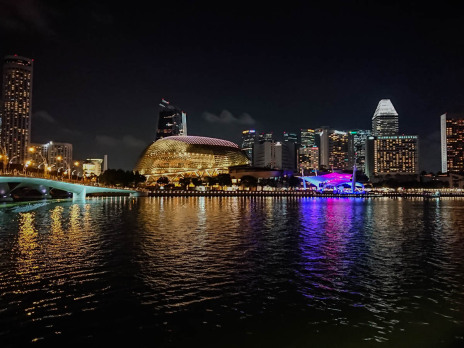
Free Performances and Outdoor Vibes
The inviting atmosphere of the Esplanade captivates tourists. With the wind and skyline of Marina Bay as your backdrop, you can enjoy live music at free outdoor concerts.
This place has a lovely, relaxed atmosphere that is ideal for relaxing beneath the stars, and both locals and visitors frequently recline here with refreshments.
Art Beyond the Stage
In addition to events, the Esplanade is home to a thriving performing arts library, a revolving art exhibit, and even a tranquil rooftop garden with breathtaking bay views.
Often missed by tourists, this hidden gem combines culture with peaceful getaways.
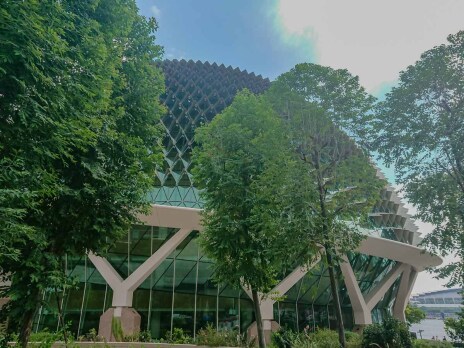
Eat, Sip, and Shop
Feeling peckish? There are several cafés, informal restaurants, and even fine dining establishments along the Esplanade.
Get a kopi (local coffee) or have a lunch beside the river.
Additionally, you'll discover creatively crafted souvenirs and local boutiques, which are excellent for finding unique presents.
Visiting Tips
How to get there: City Hall and Marina Bay are both conveniently close by, as is the Esplanade MRT Station.
Bring curiosity, your camera (the vistas are breathtaking), and maybe a picnic mat in case of an evening performance.
The best time to visit is in the late afternoon or early evening, when you can explore the area, take in the free outdoor performances, and watch the sunset.
Fountain of Wealth
Let Its Flowing Embrace Turn Your Circles Into Serendipity
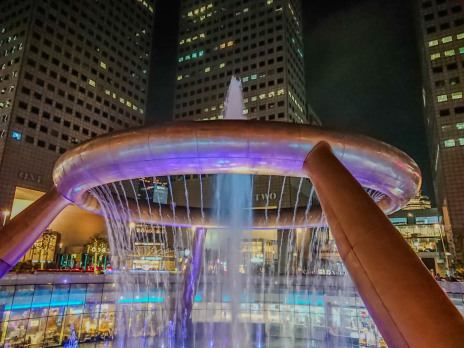
A Circle of Success
Constructed in 1995, the Fountain of Wealth, which has a 13.8-meter bronze ring, was formerly the biggest fountain on Earth and held the Guinness World Record. Its round shape, which was inspired by a Hindu Mandala, and its feng shui arrangement, which depicts water flowing inward, stand for harmony and wealth. A "hand," like a palm clutching riches, is formed by the buildings of Suntec City around the fountain.
A Fountain You Can Walk Into
This fountain encourages more than just viewing.
During certain hours, guests can enter its base and make three clockwise circles around a tiny inner fountain, rubbing their fingertips on the water for good fortune.
In the midst of Singapore's metropolitan bustle, it is an uncommon, contemplative practice.
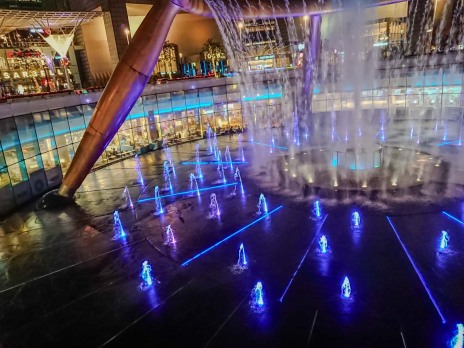
Night Lights and Water Shows
The fountain changes into a captivating display of vibrant lasers and water jets that dance to music as night falls.
It turns into a glowing focal point against the night sky. Both locals and visitors congregate for this free exhibit, which combines art, technology, and urban leisure into one remarkable experience, making it the ideal post-dinner or post-shopping treat.
A Pause Between Shops & Skyscrapers
One of Singapore's biggest retail malls, Suntec City Mall, has the Fountain of Wealth. Once you've seen the fountain, you may go shopping at hundreds of stores, eat at foreign and local restaurants, or see a movie—all under one roof.
It is the ideal fusion of convenience and culture.
The Shoppes at Marina Bay Sands
Where Curated Elegance and Urban Energy Collide Under One Radiant Roof
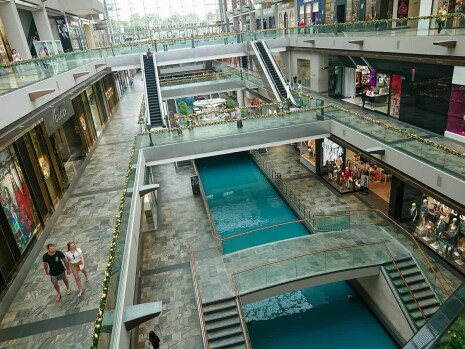
Overview
The Shoppes at Marina Bay Sands redefines premium retail, turning shopping into a spectacle. Its carefully chosen stores and modern decor, set against the famous Marina Bay background, make it difficult to distinguish between a mall and a gallery.
You're engrossed in a world where business meets couture daydreams, whether you're looking for designer finds or just enjoying the atmosphere.
Architecture & Fashion Come Together
Step into an airy realm of modern elegance, where sunlight streams through vaulted glass ceilings and polished surfaces amplify the glow.
Every angle is a photo op. Home to Louis Vuitton, Chanel, and Dior, the mall’s pristine boutiques redefine luxury retail—but even window-shoppers feel like VIPs on this runway of refined indulgence.
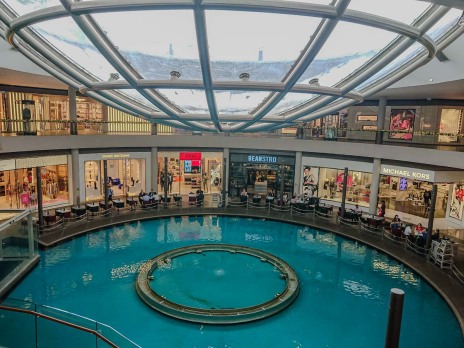
A Twist on Traditional Malls
It's surprising that a mall has a canal.
Under a glistening glass canopy, wooden sampans glide past upscale retailers at The Shoppes. This surprising aquatic twist transforms shopping into a fantasy, combining elements of Singaporean ingenuity with Italian daydreaming.
It's sheer magic, whether you ride or watch.
Culinary Delights Await
The Shoppes offers more than luxury shopping—it's a culinary paradise.
Savor world-class dining from Wolfgang Puck’s CUT steakhouse to Spago’s rooftop Californian fare.
Crave burgers? Try Black Tap’s legendary shakes. For local flavors, Rasapura Masters delivers. Pro tip: Waterside sunset dining blends elegance with Instagram-perfect views.
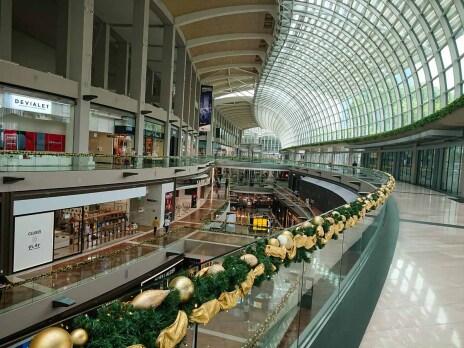
Art, Light & Elegance
Come for the luxury, stay for the creativity.
Between curated art installations and immersive light projections, The Shoppes feels like a gallery in motion.
It’s where high fashion meets high-tech whimsy—a microcosm of Singapore’s ability to weave culture, innovation, and retail into one dazzling experience.
Connection to Everything
Why stop at shopping? The Shoppes is your gateway to Marina Bay Sands’ best:
🎭 ---
Theatrical performances at Sands Theatre
🌆 ---
SkyPark’s 57th-floor panoramas
🎨 ---
ArtScience Museum’s mind-bending exhibits
💦 ---
Spectra’s dazzling bayfront light displays
ArtScience Museum
Where Creativity and Curiosity Collide
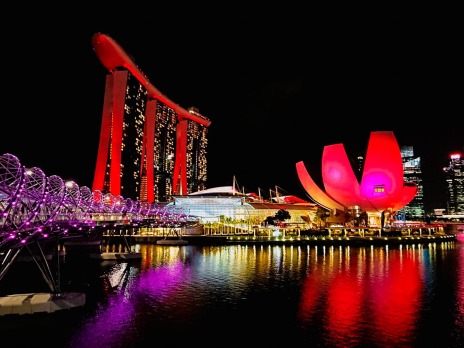
Overview
Mind-bending exhibits at the nexus of creativity and STEM may be found in the ArtScience Museum, a beacon of inspiration with a petal-like shape.
This monument inspires you to think, play, and dream, regardless of whether you're a tech nerd, art enthusiast, or just in awe of its architecture.
A Building Inspired by Nature
The characteristic building of the ArtScience Museum is a work of art, resembling both an outstretched hand and a lotus in bloom, with its 10 "fingers" each housing a distinct gallery.
Moshe Safdie, the architect, combined sustainability and sculpture in his design by directing rainfall into the center basin. The first display is the building itself.
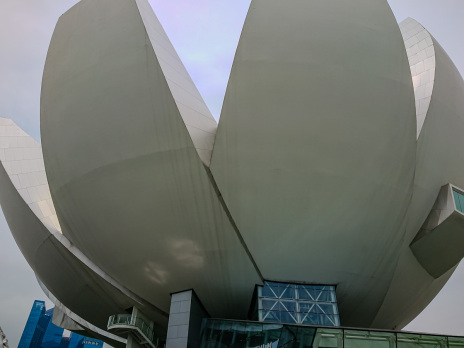
Where Art Meets Science
Visit the ArtScience Museum to discover a world where science and art coexist.
Future World, its centerpiece, turns guests into collaborators by allowing them to design virtual marine life that swims over walls, explores glowing woods, and creates dynamic lightscapes with each step.
All ages are delighted by this light and sound playground, which was created by Japan's teamLab.
Always Something New
The ArtScience Museum dazzles with ever-changing blockbuster exhibitions, including intergalactic NASA experiences, Van Gogh's brushstrokes, and Marvel superheroes. Previous blockbusters, such as Virtual Realms, elevated gaming into art. With subjects ranging from climate science to Disney enchantment, there's always something new to discover—check their website for the most recent must-see presentation.
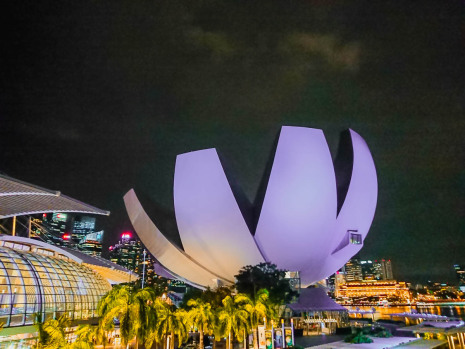
A Message for the Future
The ArtScience Museum sparks curiosity about tomorrow, challenging visitors to ponder:
Can art and science reimagine our future? How might innovation tackle global crises? More than Instagram backdrops (though it has those!), it’s a lab for big ideas—where inspiration meets introspection.
How to Visit
Location: Marina Bay Sands, 6 Bayfront Avenue
Nearest MRT: Bayfront Station
Opening Hours: Daily, 10am – 7pm (last admission at 6pm)
Tickets: Available at the entrance or online
Pro Tip: Visit on weekdays to avoid crowds, and allow 1.5–2 hours to explore comfortably.
Marina Bay Sands
Where The Skyline Wears A Crown, And Every View Rewrites 'Impossible'
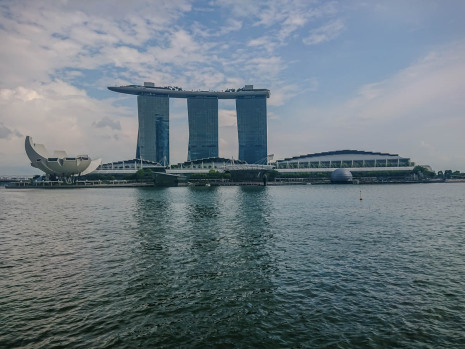
The Icon of Modern Singapore
Marina Bay Sands, the architectural masterpiece that inspired a thousand postcards, combines Vegas-style grandeur with Singaporean ingenuity.
The cantilevered sky deck is more than just a tourist attraction; it is a global emblem of aspiration.
Come for infinity pool fantasies, stay for rooftop drinks, or simply look up at the sci-fi silhouette against tropical clouds. Pure bucket-list magic.
A Hotel Like No Other
Marina Bay Sands' three sparkling buildings are topped by the gravity-defying SkyPark, which has a beautiful aerial sanctuary.
Inside, 2,500 exquisite rooms combine modern luxury with spectacular city or bay views.
Guests receive exquisite service and unique access to the world-renowned infinity pool, where the skyline serves as your own background.
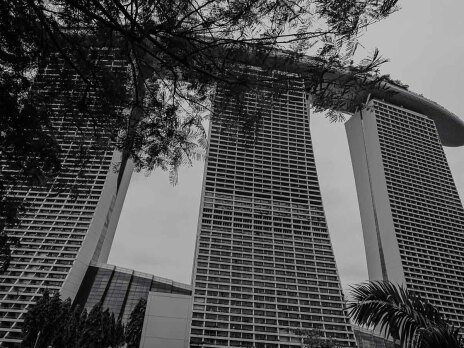
The Infinity Pool in the Sky
The famed Infinity Pool, positioned 57 stories above Singapore, is every bit as stunning as the images show.
As the world's tallest and largest rooftop pool, its disappearing edge gives the impression of swimming into the skyline.
Sunrise and sunset here are quite amazing. Pro tip: Access needs a hotel stay, so plan that splurge-worthy night!
SkyPark Observation Deck
Don't miss the SkyPark Observation Deck, which offers the greatest 360° views of Singapore without the need to stay at the hotel.
Marvel at Gardens by the Bay's Supertrees, locate faraway sailboats, and watch the Spectra light display illuminate the night.
As the light goes, the city transforms into a dazzling wonderland beneath your feet.
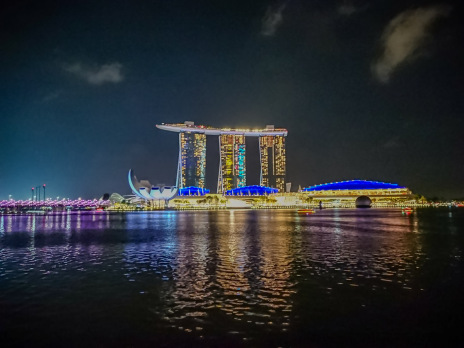
Shop, Dine & Discover
Where opulence multitasks: Cruise an indoor canal past luxury boutiques, savor steak at Wolfgang Puck’s CUT, or try your luck at the glittering casino (tourists enter free).
With celebrity chefs, designer stores, and round-the-clock excitement, Marina Bay Sands isn’t just a hotel—it’s Singapore’s ultimate see-and-be-seen destination.
Culture & Entertainment
From Broadway-style shows at the Sands Theatre to rotating art installations at the ArtScience Museum (shaped like a blooming lotus), Marina Bay Sands adds a cultural edge to its glamour.
At night, don’t miss the Spectra Light & Water Show, held daily at the Event Plaza. It’s a beautiful outdoor show that blends fountains, music, and lights—free to the public.
Gardens by the Bay
Where futuristic landscapes bloom dance with human creativity
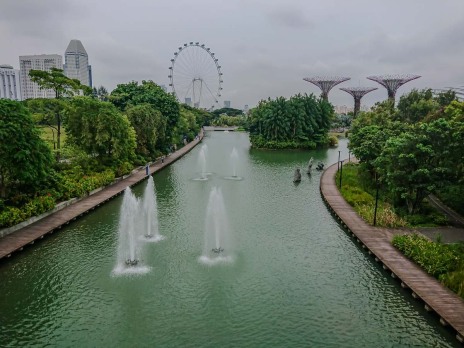
Welcome to a Garden Like No Other
Gardens by the Bay is a 101-hectare fantasy world that combines cutting-edge technology, live art, and biodiversity.
Nestled against Marina Bay's skyscrapers, this is more than just a park; it's Singapore's imaginative love letter to tomorrow's ecosystem, attracting audiences with its alien-like Supertrees, climate-controlled biomes, and ever-changing flower performances.
What Is Gardens by the Bay?
Gardens by the Bay is tomorrow’s garden realized today, featuring:
🌳Supertree Grove – futuristic vertical gardens with dazzling light shows
🌸Flower Dome – a record-breaking greenhouse of perpetual spring
☁️ Cloud Forest – a misty jungle crowned by a thunderous indoor waterfall
🌿Outdoor Gardens – lush themed landscapes with bay vistas
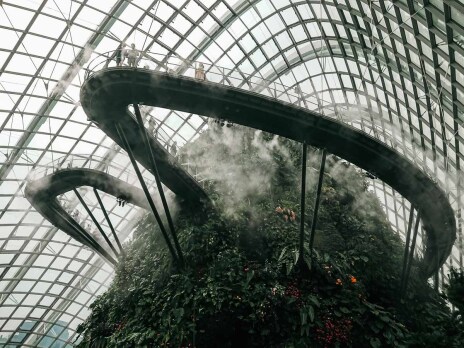
Flower Dome
A world of flowers beneath one roof: In this climate-controlled heaven, you may explore perfumed lavender fields and towering baobabs. From spring tulips to fall chrysanthemums, seasonal rotations guarantee fresh discoveries with each visit. Bonus: the air-conditioned comfort is a pleasant relief from tropical humidity, and every corner has an Instagram-worthy flower backdrop.
Cloud Forest
The Cloud Forest has a Jurassic Park-meets-future atmosphere, with a roaring cascade cascading down a plant-covered mountain. Wander through foggy treetop pathways, discovering uncommon plants and learning about biodiversity.
☁️ Chilly and humid, ideal for escaping Singapore's heat.
🌎 Designed to encourage environmental action.
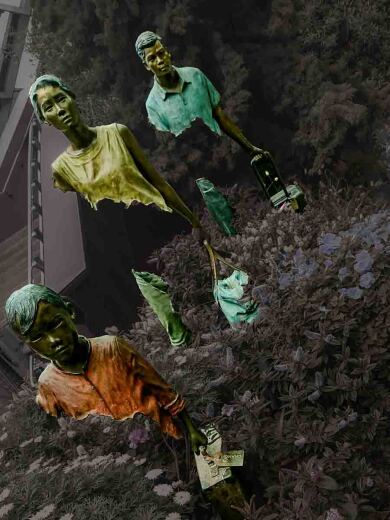
Supertree Grove
At Gardens by the Bay, Supertree Grove's 18 soaring vertical gardens (25-50m tall) steal the show.
These futuristic giants, shrouded in ferns and orchids, also serve as eco-warriors, capturing solar electricity throughout the day. Return after dark for the free Garden Rhapsody, in which the grove is transformed into a synchronized light symphony.
Hidden Gems and Outdoor Gardens
Beyond the iconic attractions, discover hidden gems:
🌿 Heritage Gardens:
plants woven into Singapore’s multicultural history
🐝 Kingfisher Wetlands:
serene boardwalks alive with birdsong
🎨 Art installations:
from The Travelers to the gravity-defying Floating Baby

Best Time to Visit
☀️ Late afternoon to evening:
Explore the conservatories first, then enjoy sunset views
🌃 Evening:
Don’t miss the Supertree light show
🧭 Allow at least 3–4 hours,
more if you plan to explore everything
How to Get There
🚇 MRT:
Bayfront Station (Exit B) on the Downtown Line
🚶 Short walk:
via the underground linkway or across the Marina Bay Sands bridge
🎟️ Admission:
Outdoor gardens are free, but conservatories and Skyway require tickets
Dragonfly Lake
Nature and Calm in the Heart of Singapore
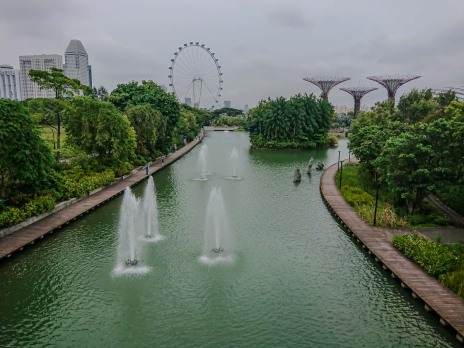
Overview
Dragonfly Lake, a tranquil oasis in a forward-thinking landscape, combines ecological marvel with contemplative beauty.
Watch jewel-toned dragonflies skim the lake while you recharge in the frenetic energy of Singapore.
It demonstrates that even in a city concerned with the future, nature still writes the most relaxing love messages.
A Lake Full of Life and Meaning
Dragonfly Lake is not just called for its shimmering winged guests; these species represent balance and rebirth, reflecting Gardens by the Bay's connection with nature.
Beyond symbolism, the lake flourishes as a living filter, with aquatic plants and fish purifying water and promoting biodiversity, making it both lyrical and functional.
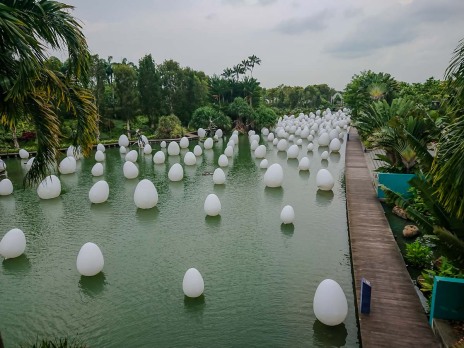
A Peaceful Stroll with a View
For the best Dragonfly Lake experience, take a stroll across the scenic Dragonfly Bridge.
This elevated walkway offers sweeping views of the tranquil waters and neighboring Supertree Grove. Peer into the crystal-clear lake below to discover vibrant fish and aquatic plants—a magical sight at sunrise or sunset when the water glows like glass.
A Hidden Gem for Photography
Your lens will work overtime here.
Between golden-hour silhouettes, jewel-toned dragonflies in mid-flight, and the Supertrees' neon glow reflecting in the water at night, Dragonfly water provides countless composition possibilities.
The Marina Bay Sands skyline peaking through vegetation offers urban contrast—all in one serene, tripod-friendly setting.
Flower Dome
A World of Blossoms Under Glass
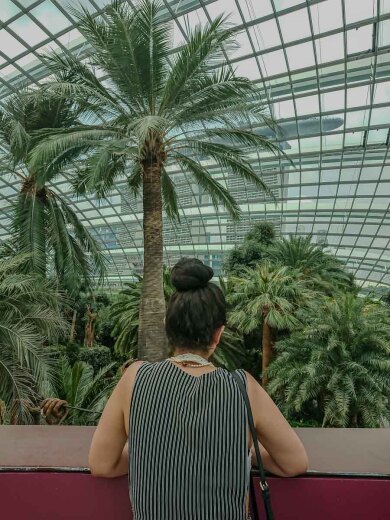
A Blooming Marvel
Step into a climate-controlled Eden at the Flower Dome, where Mediterranean flowers and exotic succulents grow year-round beneath soaring glass archways.
Whether you're photographing rare orchids or simply inhaling the scent of continuous spring, this record-breaking greenhouse transforms each visit into a sensory celebration of nature's brilliance.
Climate-Controlled Wonders
The Flower Dome offers a refreshing escape—maintaining a comfortable 23-25°C (73-77°F) climate that contrasts Singapore's tropical heat.
This innovative greenhouse recreates Mediterranean and semi-arid zones, letting you admire tulips, ancient baobabs, olive groves, and desert cacti in perfect harmony—all under one spectacular glass roof.
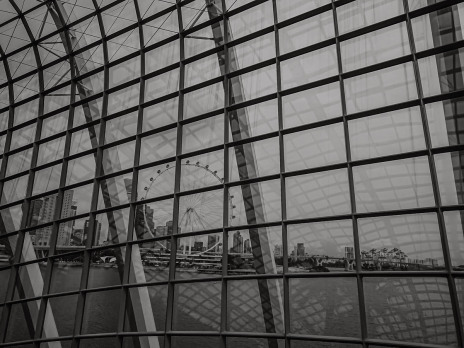
A Journey Through Global Gardens
The Flower Dome whisks you across continents through its themed gardens:
🌿 Mediterranean:
Fragrant olive trees & lavender
🌵South America:
Towering cacti & bromeliads
🦘Australia:
Quirky bottle trees & kangaroo paws
🌸 South Africa:
Bold proteas & aloes
Nature’s Art Gallery
The dome, like a floral chameleon, changes its botanical clothing periodically, from sakura in March to sunflower labyrinths in August and golden chrysanthemum cascades during the Mid-Autumn Festival.
When Lunar New Year or Christmas approach, get ready for next-level whimsy—think poinsettia "snowmen" or orchid lantern forests. Nature's theater features ever-changing acts.
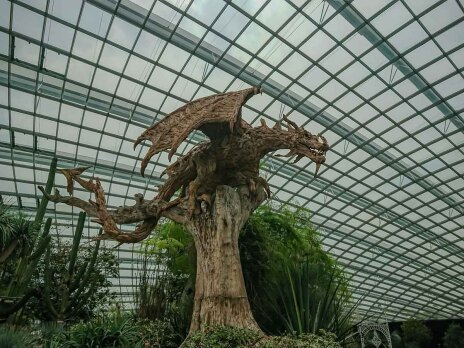
Sustainable Beauty
The dome's design, a green marvel in every respect, uses smart glass, efficient cooling, and recycled rainwater to reduce energy use.
It's more than just a gorgeous face; it's a model for how modern construction may foster, not battle, the natural environment.
Perfect for Photos and Peace
The Flower Dome is a refuge for leisurely living, combining Instagram-worthy scenery with calm places for quiet thought.
Wander amid the blossoms at your own leisure, take envy-inducing images, or simply relax for a while—every nook is meant to let visitors reconnect with nature's soothing rhythm.
Cloud Forest
A Misty Escape into Nature’s Secrets
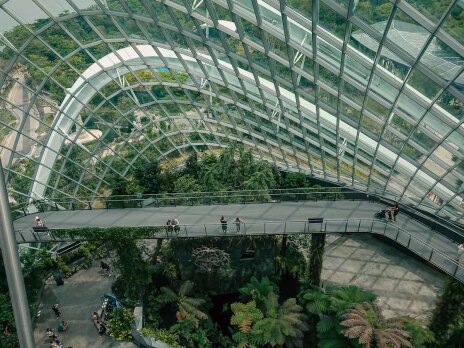
A Cool Mist in the Tropics
A climate-bending marvel, the Cloud Forest wraps visitors in 21°C mountain-air freshness.
The second you pass through its glass walls, the roar of a 35-meter waterfall and emerald ferns transport you to an otherworldly jungle canopy—no altitude required.
This isn’t just a greenhouse; it’s Singapore’s most surreal natural mirage.
World's Tallest Indoor Waterfall
A breathtaking 35-meter waterfall welcomes you to the Cloud Forest, its mist-kissed cascade tumbling down a verdant mountain.
The soothing roar and cool spray set the stage for wonder, while its dramatic beauty promises unforgettable photos.
This isn’t just an attraction—it’s the beating heart of the dome’s magic.
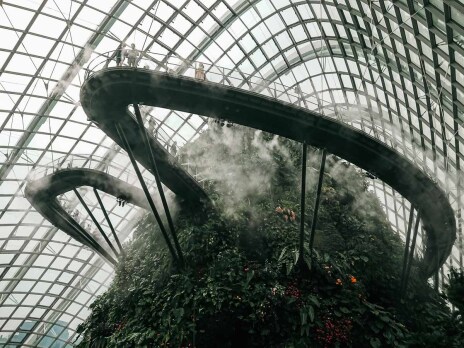
Nature on Every Level
An elevator whisks you skyward to Cloud Mountain’s summit, where thin-air flora thrives. Wind down through:
☁️ Lost World:
Mist-laden high-altitude plants
⛰ Crystal Mountain:
Geological wonders
🌿 Treetop Walk:
Canopy-level boardwalks
✨ Secret Garden:
Pocket-sized botanical jewels
A Story of Climate & Conservation
This dome is more than just a jungle illusion; it teaches you the secrets of the cloud forest.
Touchscreens and exhibitions explore their sensitive position in the Earth's climate, with kid-friendly twists.
You'll leave not only awestruck by waterfalls, but also equipped with knowledge about biodiversity's frontline.
Ideal for families who value both beauty and intelligence.
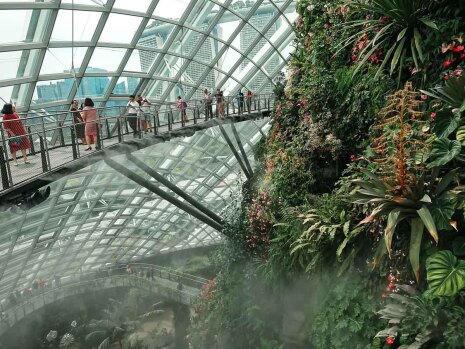
A Visual and Sensory Wonderland
The dome exudes magic: artificial clouds dance among prehistoric ferns, and gentle lights paint the flora in fairytale colors.
The waterfall's distant roar and the mist swirling around your ankles create a multisensory dreamscape that is a combination of botanical marvel and fairytale delusion.
Plan Your Visit
🕒 Opening Hours:
9 AM – 9 PM daily (last admission at 8 PM)
🎟️ Ticket Info:
Available online; often bundled with Flower Dome for better value
🧥 What to Bring:
A light jacket—it can get quite chilly inside!
📷 Photography Tip:
Go early for less mist on your camera lens and fewer crowds on the walkways
Cavenagh Bridge
Where History Meets the River
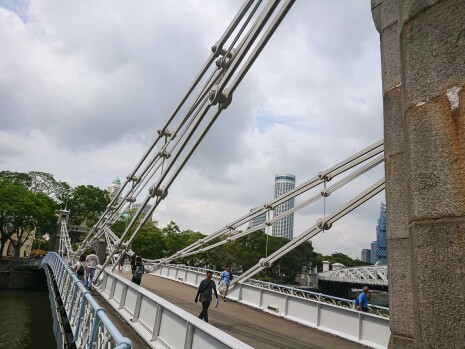
A Bridge Frozen in Time
Cavenagh Bridge, a wrought-iron time capsule, has linked Singapore's coastlines since 1869 and is the only bridge that has survived in its original shape.
Stroll beneath its elegant suspension arches, where merchants and officers used to hurry.
More than steel and rivets, it's a poem about perseverance that connects previous whispers to contemporary footsteps.
A Touch of Victorian Charm
Cavenagh Bridge, a Scottish-born gem in Singapore, exudes Victorian-era grandeur with its fluted lighting, scalloped suspension chains, and lace-like ironwork.
It was dismantled and moved overseas in 1869 before being reconstructed piece by piece, and it is today a treasured monument where history enthusiasts and Instagrammers come together beneath its ageless arches.
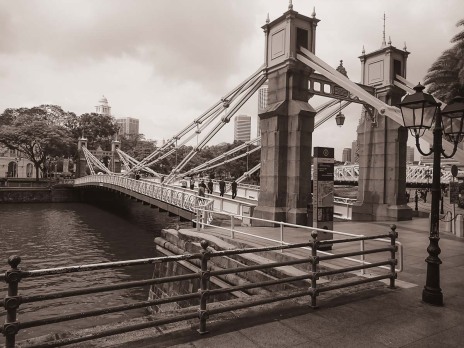
Time-capsule Humor
The bridge's historic sign, which prohibits animals and large carts (150kg maximum!) still exists, although today's visitors pose beside it rather than respect it.
This cheeky antique from 1869 nods to Singapore's pastoral past while serving as one of the city's most photographed historical Easter eggs.
Connecting the Old & the New
Linking Empress Place to the Fullerton Hotel, Cavenagh Bridge beautifully bridges Singapore’s colonial past and modern luxury.
Flanked by historic landmarks and contemporary icons—like the Asian Civilisations Museum and Merlion Park—it’s a picturesque crossroads where history meets today’s vibrant cityscape.
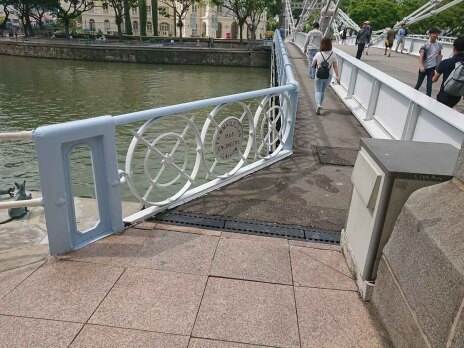
A Peaceful Spot by the Water
At sunset, the bridge changes into a front-row seat for nature's light display, providing a respite from the city's hustle and bustle.
As the river reflects skyscrapers and old facades, you'll find yourself grabbing for your camera—or simply enjoying this live picture of Singapore's past and present in perfect harmony.
Light Up the Night
Night reveals the bridge's magic:
gentle lights trace its Victorian curves, while the river amplifies their radiance.
With Marina Bay's skyline as a background, it transforms into a lantern-lit promenade for lovers and dreamers, demonstrating that even old iron can learn to dance with modern city lights.
The Travelers
A Sculpted Story in the Flower Dome
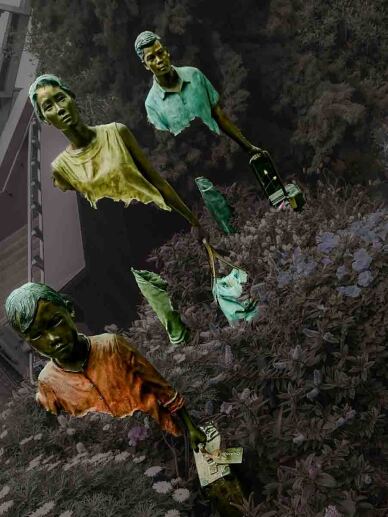
Art Meets Nature
Between baobabs and orchids, silent storytellers float—The Travelers exhibit breaks the Flower Dome's foliage with transparent individuals in mid-journey.
More than art, they serve as lyrical pauses, reminding us of migration, impermanence, and our own position in nature's fabric.
A moment of silence in a garden that is normally bursting with color.
Who Are "The Travelers"?
The Travelers, by French artist Bruno Catalano, displays startling bronze figures with hollowed-out torsos that appear to have vanished in mid-stride.
Nonetheless, they continue on, bags in hand, representing life's adventures and the fragments we leave behind.
These wounded but determined wanderers reflect on resilience, loss, and the universal act of moving ahead.
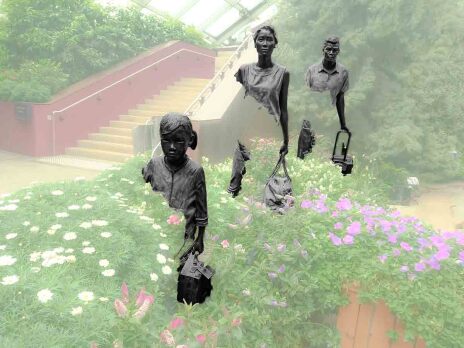
Suspended in Motion
The Travelers float through the Flower Dome's greenery like phantom wayfarers, their shattered bronze shapes suspended in mid-step. With bags, literature, and comfortable postures, they may be immigrants, explorers, or today's globetrotters. Their strange incompleteness raises the question: what is lost in transit? What journeys have formed them? A weird, intimate interplay between art and nature.
A Symbol of Universal Journey
It refers to all journeys, whether geographical or personal. These shattered forms, created by migrants in Singapore, sensitively represent the common experience of relocation. Their missing parts reflect what we all leave behind—homes, customs, and loved ones—while their onward leaps commemorate resiliency. Not ruins, but testaments to the strength required to carry fragmented identities on into new chapters.
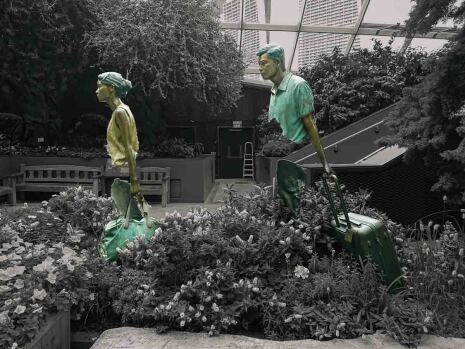
Why You Shouldn't Miss It
"The Travelers" takes the Flower Dome beyond biology, incorporating human stories throughout its flowery tapestry.
These sculptures commemorate the invisible hands—migrants, traders, and explorers—that built our world's gardens.
Where flora celebrate nature's diversity, figures speak of human journeys, resulting in a moving conversation between horticulture and culture, roots and paths.
Photo Tips
📷 Best angle:
Try capturing the sculptures from slightly below or at eye level to emphasize the "floating" effect.
🎨 Details:
Don’t forget to zoom in on the textures—wrinkled clothes, weathered faces, and small personal items in their hands.
🕯️ Mood:
Visiting during quieter hours enhances the contemplative atmosphere.
Supertree Grove
Nature’s Giants Lighting Up the Sky
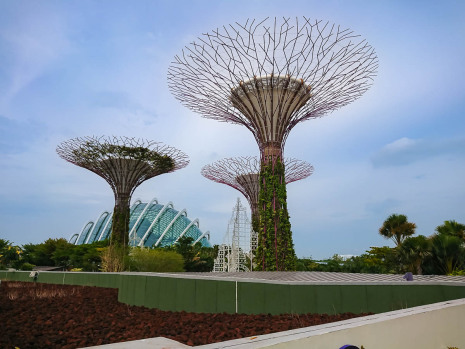
Overview
Imagine wandering through a grove of trees built of steel, glass, and solar panels, rather than wood.
Welcome to the Supertree Grove, one of Singapore's most recognizable attractions, situated in the middle of Gardens by the Bay.
These towering vertical gardens appear like they belong in a sci-fi film, yet they're really real and completely amazing.
What Are Supertrees?
The Supertrees are futuristic marvels—towering vertical gardens up to 50 meters tall, clothed in over 158,000 tropical plants.
Aside from their attractive appearance, they serve eco-functions: solar panels power nocturnal light shows, rainwater collectors water gardens, and some direct cold air to adjoining conservatories.
A beautiful combination of nature and ecological technology.
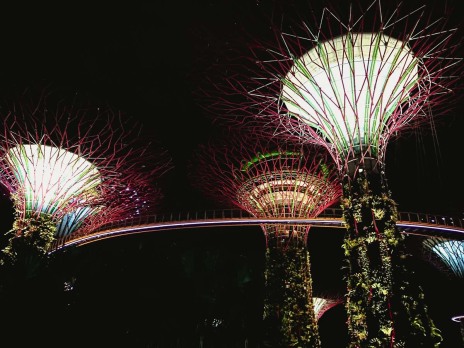
Walk Among the Giants
Enhance your experience by wandering the OCBC Skyway, a 128-meter-high walkway that connects two Supertrees.
Enjoy stunning views of Marina Bay's skyline, the Gardens below, and the iconic Marina Bay Sands. For a magnificent experience, visit around sunset, when the city lights golden.
💰 Affordable tickets available!
The Garden Rhapsody Light Show
Supertree Grove dazzles at night with Garden Rhapsody, a free light-and-sound show in which the trees pulse to music (7:45PM & 8:45PM).
Themes vary from Mozart to Marvel, but what is the actual magic? Lying underneath them, you see 50-meter-tall lights dance across your line of vision like bioluminescent giants.
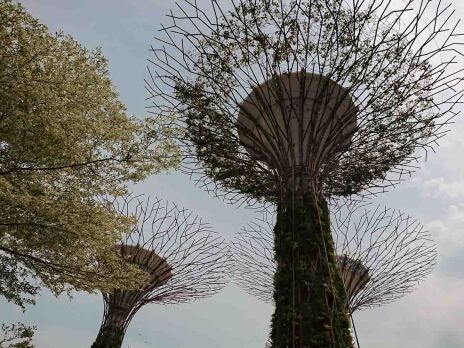
Nature + Technology = Wow
Beyond their splendor, the Supertrees serve as symbols of possibility. They demonstrate that urban environments don't have to compromise nature for progress.
Singapore's integration of solar panels, vertical gardens, and renewable technologies in these behemoths sets a precedent for cities throughout the world: where steel supports life and sustainability becomes creativity.
Photo Tips
📸 Daytime:
Capture the contrast between the lush plants and steel frames
🌇 Golden Hour:
Best time for warm lighting and fewer crowds
🌃 Night:
Bring a tripod or steady your camera for amazing light show shots
Makansutra Gluttons Bay
Singapore's Ultimate Street Food Feast
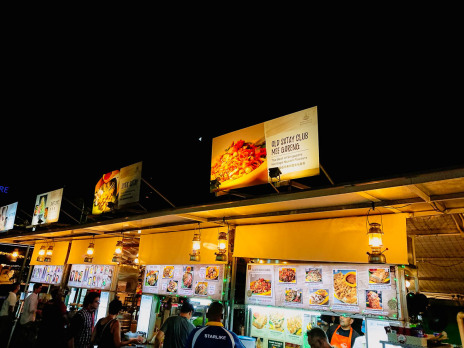
A Foodie Paradise by the Bay
Locals recommend Makansutra Gluttons Bay for authentic street cuisine in Singapore.
Nestled adjacent to the Esplanade, this outdoor feast location gives up the city's delicacies under glittering lights—where sizzling woks, chili crab scents, and laughing guests demonstrate that real food need not require walls.
What Is Makansutra Gluttons Bay?
KF Seetoh's delicious masterpiece, this open-air exhibition of hawker stars delivers Singapore's culinary ABCs.
Hainanese chicken rice, charred satay, and roti prata so flaky you could moonwalk.
Perched on the Esplanade, it's where culinary reviewers and hungry travelers come together over communal tables and $5 flavor bombs. Come for the chilli crab, stay for the authentic kampung vibe that no mall food court can replicate.
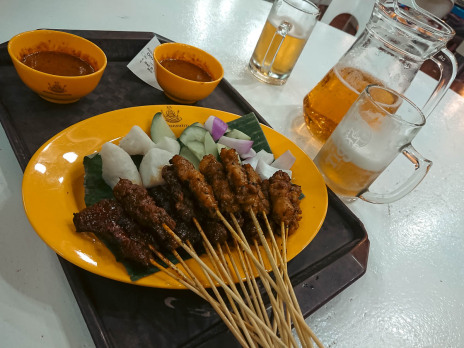
What to Eat: Signature Must-Tries
Gluttons Bay’s hall of fame:
1️⃣
Hokkien Mee’s umami smoke
2️⃣
Satay’s peanut-dipped perfection
3️⃣
BBQ Stingray’s spicy banana-leaf hug
4️⃣
Char Kway Teow’s wok-kissed decadence
5️⃣
Ice Kachang’s rainbow chill
Casual, Colorful, and Alive
No frills, just flavor—Gluttons Bay is Singapore street eating at its finest.
Perched on plastic chairs under the starlight, you'll dine among locals while the Marina Bay Sands glitters across the ocean.
With sizzling woks, live Esplanade sounds, and communal tables teeming with stories, this is where the city's pulse beats the tastiest.

